Inclusive design
Strategy
and planning for all ākonga to belong, participate, and succeed
Inclusive sport design lowers barriers to physical activity

Cyclone response takes home-schooling to new level
He Ara Tika: Ākonga embrace the pathway to success
24 APRIL 2023 | VOL. 102 | NO. 5
Want to know about all things digital?
Get the latest updates on digital initiatives, digital security, new services, tips and advice straight into your inbox each month.
As Te Tāhuhu o te Mātauranga | Ministry of Education continues to make new digital services, initiatives and advice available to schools and kura – we want you to stay informed.


Sign up to our monthly newsletter with useful information for IT leaders –The Digital Download.

The Digital Download covers:
• Guidance on digital security, online safety, and privacy
• Early access to services
• Upcoming events and how to be involved
• Everything digital from the Ministry!

It’s your gateway to information to proactively keep your school’s IT setup secure.
Go to www.bit.ly/sub2DD or scan to subscribe now!

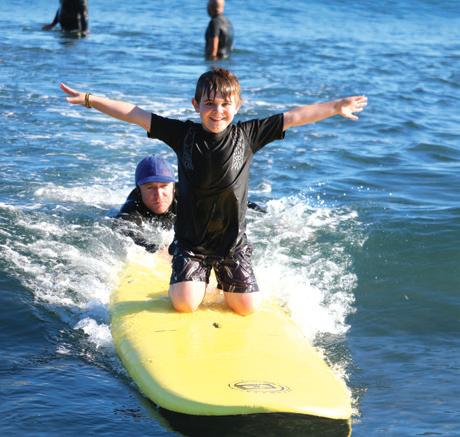

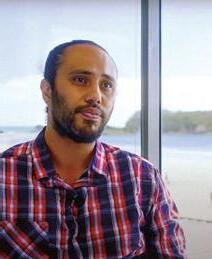

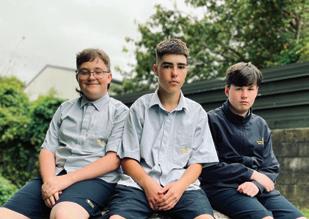
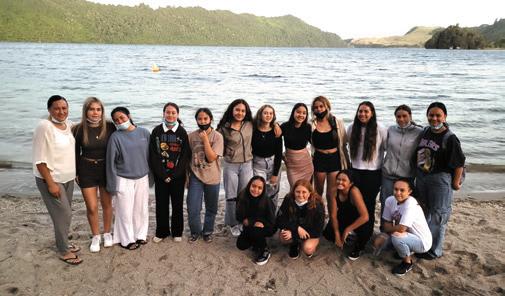
1 Tukutuku Kōrero 4 Inclusive sport design lowers barriers to physical activity 10 The balancing act of student engagement and support 16 Tauira to Tumuaki: Reg Blake gives back to his kura in Tauranga 20 Cyclone response takes home-schooling to new level 24 He Ara Tika: Ākonga embrace the pathway to success 28 Finding flow turns attendance tide 32 Ākonga find belonging and connection with Pāpāmoa Pou 36 How schools can embrace better online safety and security 40 Bilingual science kits give kaiako confidence 46 Rural school strengthens place at heart of community On the cover Page 4. Sophie enjoys taking part in a Taranaki Whānau Day with The Halberg Foundation. Whānau Days are an opportunity for tamariki and rangatahi with physical disabilities to come together and have a go at a variety of sport and recreational activities alongside their family and friends. 24 APRIL 2023 VOL. 102 NO. Strategy and planning for all ākonga to belong, participate, and succeed Inclusive design Inclusive sport design lowers barriers to physical activity He Ara Tika Ākonga embrace the pathway Cyclone response takes home-schooling to ISSUE 102.5 Contents Spotlight on inclusion and engagement 4 16 10 20 24 28 24 April 2023
Get this in your inbox!
Read each new edition before it’s in print by subscribing to the Tukutuku Kōrero | Education Gazette newsletter. You will get the latest content straight to your inbox, including bonus online articles, videos and podcasts.
Education Gazette Publication dates
To view the PLD, general notice listings and vacancies at gazette.education.govt.nz
Scan the QR codes with the camera on your device.
PUBLISHED BY
Education Gazette is published for the Ministry of Education by NZME. Educational Media Ltd. PO Box 200, Wellington.
ISSN 2815-8415 (Print)
ISSN 2815-8423 (Online)
All advertising is subject to advertisers agreeing to NZME. Educational Media’s terms and conditions www.advertising.nzme.co.nz/ terms-conditions-credit-criteria
STORY IDEAS
We welcome your story ideas. Please email a brief (50-100 words) outline to: gazette@education.govt.nz
SUBSCRIPTIONS
eleni.hilder@nzme.co.nz
VIEW US ONLINE Web: gazette.education.govt.nz
Instagram: @edgazettenz Youtube: youtube.com/ edgazettenewzealand
PLD
KEY CONTACTS
Reporter gazette@education.govt.nz
Display & paid advertising
Jill Parker 027 212 9277 jill.parker@nzme.co.nz
Vacancies & notices listings
Eleni Hilder 04 915 9796 vacancies@edgazette.govt.nz notices@edgazette.govt.nz
DEADLINES
The deadline for display advertising to be printed in the 15 May 2023 edition of Education Gazette is 4pm on Friday 28 April 2023.
VACANCIES NOTICES
2 Education Gazette gazette.education.govt.nz This publication is produced using FSC® Certified paper from Responsible Sources.
2023 TERM 2 EDITORIAL ADVERTISING BOOKING DEADLINE VACANCY BOOKING AND ALL ARTWORK DEADLINE BY 4PM PUBLICATION DATE 102.6 28 April 3 May 15 May 102.7 19 May 24 May 6 June 102.8 9 June 14 June 26 June 2023 TERM 3 EDITORIAL ADVERTISING BOOKING DEADLINE VACANCY BOOKING AND ALL ARTWORK DEADLINE BY 4PM PUBLICATION DATE 102.9 30 June 5 July 17 July 102.10 21 July 26 July 7 August 102.11 11 August 16 August 28 August 102.12 1 September 6 September 18 September
Spotlight on equal opportunities
Nau mai hoki mai, welcome back to school e ngā kaiako me ngā tumuaki! To kick off term 2, we’re exploring intentional schoolwide practice, strategy and planning that supports inclusive opportunities for all ākonga.
Ahead of the International Symposium of Adapted Physical Activity in June, we unpack how schools and kura can create an environment where all ākonga have an equal opportunity to participate in, and celebrate, sport.
Across the mighty Waikato and the Bay of Plenty, read about learning and wellbeing initiatives bringing disengaged students back into the fold, supporting them to reach their potential and beyond. At the heart of these are opportunities that give ākonga and their whānau a deeper connection to culture and community.

Never short of an inspirational educator to kōrero with, in this edition we profile Te Kura Kaupapa Māori o Otepou tumuaki Reg Blake, who is giving back to the kura he attended more than 18 years ago. Reg talks about the importance of community involvement, particularly in building resilience amongst tamariki.
As we plan content and articles for terms 2 and 3, we’re keen to hear more ideas from you! We’re particularly interested in hearing from early learning services and kōhanga reo, so we can ensure Tukutuku Kōrero | Education Gazette is publishing information and inspiration from across the education sector. Please send your ideas to gazette@education.govt.nz.
Kia pai te rā
Sarah Wilson Ētita | Editor
EDITOR’S NOTE
3 Tukutuku Kōrero 24 April 2023
Pāpāmoa Primary School has a new Pou school house system that gives ākonga a sense of belonging and connection to each other, to their place in the wider community, and to mana whenua.
Inclusive sport design lowers barriers to physical activity
This year, for the first time, New Zealand will host the International Symposium of Adapted Physical Activity. ISAPA 2023 is an opportunity to share knowledge and experience in professional preparation, research, advocacy, and service delivery in the fields of adapted physical activity, physical education, and sport science.

Education Gazette had a kōrero with symposium speaker Michael Woods about creating an environment where all ākonga have an equal opportunity to participate in, and celebrate, sport.
Adapted physical activity gives everyone equal opportunity to participate, regardless of their abilities or identity.
INCLUSION
From small beginnings as a resource blog in 2017, Michael Woods’ Inclusive Sport Design has grown into a business that works to welcome, involve and celebrate more people playing and competing in sports.

Michael says he originally created the blog as a platform to share information, best practice resources and things he’d learned along his own practitioner journey.
“I wanted to create the resource I wish I had access to when I started my career,” he says.
Now, the business provides consulting, advisory and education services to the sports industry, including sports organisations, clubs and volunteers.
“The ultimate goal is to create solutions for sport that help inclusion happen at scale so everybody can be involved, welcomed and celebrated in sport,” he says.
Michael is working to create an environment in the sporting world where everyone has an equal opportunity to participate, regardless of their abilities or identity.
“In my experience, generally speaking, most people involved in delivering sport don’t lack the willingness to create inclusive environments but rather they lack the skills and knowledge to convert that willingness into meaningful action,” he says. “So that’s where inclusive sport design comes in.”
Removing barriers
People with disabilities and other minority groups can face many barriers that make it harder for them to participate in sports. People with disabilities often struggle with accessibility, equipment and attitudes, and minority groups can face discrimination and bias which prevents full engagement. Compounding these issues, financial barriers can also be a significant hurdle.
Michael explains these barriers result from sport environments and cultures not having an array of individual needs in mind.
“It’s essential to recognise these barriers can overlap and intersect too, creating even more obstacles for individuals who belong to multiple minority groups,” he says.
Michael believes successful inclusion in sports always begins with understanding. He says to ask your students what they need and how they would like to play, always keeping in mind, “how can I ensure participation for everyone?”
Once teachers and coaches understand the needs, preferences and goals of participants, they should then adapt and modify their sport activities to meet those needs.
“Change how you teach, change or adapt the equipment you use, modify the field of play and even change the rules of the game,” he says.
“This should be matched with a positive, empathetic and creative attitude, with a focus on finding solutions to ensure meaningful participation for everyone.”
Academic meets practical
Methods like TREE or STEP can be used to help change sport programmes. For Michael, he believes it starts with building the capability and confidence to take action on inclusion.

5 Tukutuku Kōrero 24 April 2023
“[ISAPA] is an opportunity to listen, learn and generate new ideas to advance adaptive sport and physical activity.”
Michael Woods
Sophie enjoys a Taranaki Whānau Day with The Halberg Foundation.
Alex loves learning how to surf at a Taranaki Surf Day.
One example from Michael’s programme is his work at Swimming Australia. While working with the organisation, he worked to advance Multi Class disability competition, classification systems and other inclusive policies.
During this time, he got involved in the Australian school sport system, helping to replicate the swimming systems and policies in the school swimming competition environment. This directly led to a growth in student participation.
Michael says it’s important for schools to understand both the academic aspects and practical ways to make sports more inclusive.
Academic knowledge can be used to create policies and guidelines that promote inclusion.
This can then be paired with practical knowledge to implement the policies and practices in the real-world, day-to-day delivery of sport activities.
“By combining both types of knowledge, schools can
create a more welcoming and inclusive sports environment that benefits all students,” says Michael.
Michael notes that teachers also have an important role beyond sport delivery.
“Teachers play an important role in connecting students to further sport pathways; this is especially so for people with disabilities,” he says.

“So teachers should also be familiar with local sport options and help students access these to extend their sporting participation.”
A toolbox of ideas
Michael is a keynote speaker presenting at the 2023 International Symposium of Adapted Physical Activity. This year’s theme is innovation, adaptation and accessibility in a changing world. Michael will be sharing with participants practical ways to plan sustainable and inclusive sports programmes.
“More often than not practitioners start and end their
6 Education Gazette gazette.education.govt.nz
“Most people involved in delivering sport don’t lack the willingness to create inclusive environments but rather they lack the skills and knowledge to convert that willingness into meaningful action. That’s where inclusive sport design comes in.”
Michael Woods
Above and right: John Sigurdsson, lead advisor at The Halberg Foundation, demonstrates adaptive physical activity to a young group of participants.
inclusion thinking with the activity itself – what and how people play,” he says, “but many other factors influence the success or failure of inclusive or adaptive sport programmes.”
His session will explore those factors, aiming to provide participants with a toolbox of ideas they can use to increase the chances of engaging and retaining participants in their
Top Five Tips for teachers creating an inclusive sporting environment
1. Ask students how they want to play and what support they need (then implement this)
2. Adapt and modify your sport activities to meet the needs and preferences of students (get creative)
3. Offer choice in how students can participate (choice is the friend of inclusion)
4. Always work towards meaningful participation (no is not an option)
5. Find a mentor, another coach or teacher doing it well (then model their practice)
home sport environments.
Michael is encouraging people to attend ISAPA this year. He believes it is an excellent opportunity to connect in person after Covid had affected the event for a number of years.
“It’s an opportunity to listen, learn and generate new ideas to advance adaptive sport and physical activity – especially considering the impacts of the last few Covid years have negatively impacted people with disability more than most,” he says.

Michael says the sports industry has a responsibility to create environments that support the needs and wants of people with disabilities.
Ultimately, sport and physical activity provides numerous benefits to participants. It offers improvements to physical health and also supports positive mental health. To each student and educator, it’s an invaluable part of the curriculum.
“Central to this, is the great potential for building social connections, finding meaning and developing individual capacity that helps people live better lives,” says Michael.
7 Tukutuku Kōrero 24 April 2023
International Symposium of Adapted Physical Activity
ISAPA 2023 will be held from Sunday 25 June to Thursday 29 June, co-hosted by the University of Otago and Mooven in Ōtepoti Dunedin.
An Adapted Physical Activity Sport and Recreation Day will also be hosted by The Halberg Foundation, Paralympics NZ, Blind Sports NZ, Special Olympics and Parafed Otago.


The symposium is held every second year to provide physical activity professionals with an opportunity to share their knowledge and experience in professional preparation, research, advocacy, and service delivery in the fields of adapted physical activity, physical education, and sport science.
ISAPA programmes include research presentations, innovative sessions for the discussion of new ideas, practical workshops, and some social events. This will be the first time ISAPA will be held in New Zealand.
The week’s programme includes several international speakers who will share their expertise from both an academic and practioners’ perspective. These include Professor David Howe (Western University Ontario), Dr Emma Beckman (University of Queensland), Professor Simon Darcy (University of Western Sydney), Andrew Leslie (Nuku Ora) and Michael Woods (Inclusive Sport Design, Australia).
There will also be a showcase of the great mahi being achieved throughout the motu within the education sector. This is an important opportunity to learn about new initiatives, connect with colleagues around Aotearoa and develop new working relationships with national and international colleagues.
8
more and register at isapa2023.com
Learn
Eliza with volunteers from the Oakura Boardriders, who work with The Halberg Foundation to give children and young people with disabilities a day at the beach and the opportunity to learn how to surf.
Tara with volunteers from the Oakura Boardriders.
Safe speeds around schools
Shoot marbles, gather data, use evidence: a DP shares insights about how primary science teaching anchors a new cross-curricular resource for Years 1-8.
Students take turns with a hand-made device –2 cardboard tubes, 2 rubber bands, a pencil. It’s a marble launcher and they’re taking aim at a paper cup. You can see the concentration in their eyes.
Someone releases the rubber bands. Boom, the marble flies out, knocking the cup backwards. A teammate records the exact distance moved. There’s laughter, fun.
Watching with interest is Rāroa Normal Intermediate School
Deputy Principal Matt Boucher. Matt has worked with Waka Kotahi to write a new curriculum resource, called Safe speeds around schools, which you can find at education.nzta.govt.nz The marble launcher features in Lesson 2.

Overall, the unit has 3 lessons about changing speed limits around New Zealand’s schools. With all schools involved in the coming years, young people have a rich local context for persuasive writing, presentations and hands-on science.
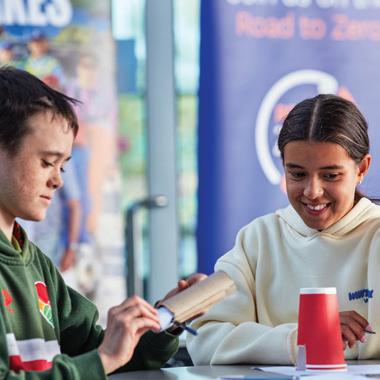
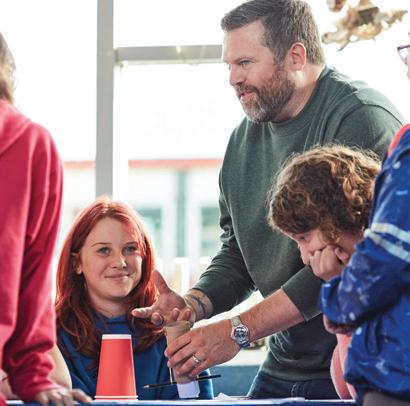
‘Kids get told all kinds of messages. We tell them what the rules are, but they don’t always get an explanation of why those rules are in place, other than just saying it’s for your safety,’ says Matt.
‘Buy-in for kids comes from understanding, and one of my teaching philosophies is exploration before explanation. Students need to have a play with a concept – and then it makes sense for them at a different level because they’ve seen it for themselves in action.’
Soon, his students discuss how the greater the speed of the marble, the greater force it exerts on the cup. He asks the group to extrapolate this information to road crashes.
‘It was a very clear picture for them that if a vehicle is moving slower, the likelihood of injury or damage is a lot less. The learning is deeper for them having paired these ideas after seeing it themselves through proper experiment.’
Matt says the sweet spot in primary science teaching is hands-on learning in which the deliberate use of scientific skills is strong.
‘It might not literally be explosions, whizz-bang stuff, but the kids are involved and having fun. We’re looking at science capabilities. Students gather and interpret data; they’re taking their own measurements through these experiments. And then making sense of it, using evidence – the patterns they recognise – using that to form conclusions.’
The Safe speeds around schools resource aligns to achievement objectives in Science, Social Sciences, and Health and PE. It includes adaptations for Years 1-3, 4-6 and 7-8. It can be used as a whole unit of work, or activities can be used as one-off lessons. Free to download from education.nzta.govt.nz
education.nzta.govt.nz
Schools can sign up with Brake for a free electronic action pack of lesson plans, activity sheets and posters. The theme of Road Safety Heroes recognises everyone who works to make our roads safer and highlights the part we all play.
www.roadsafetyweek.org.nz/action-pack
23-EX-033 15-21 May ADVERTORIAL
SCHOOL
LEADERSHIP
The balancing act of student engagement and support
By tracking attendance and following up with students in a nonjudgemental, nonpunitive and understanding manner, teachers and senior leadership at a Paeroa school have been able to implement methods to help students in need.
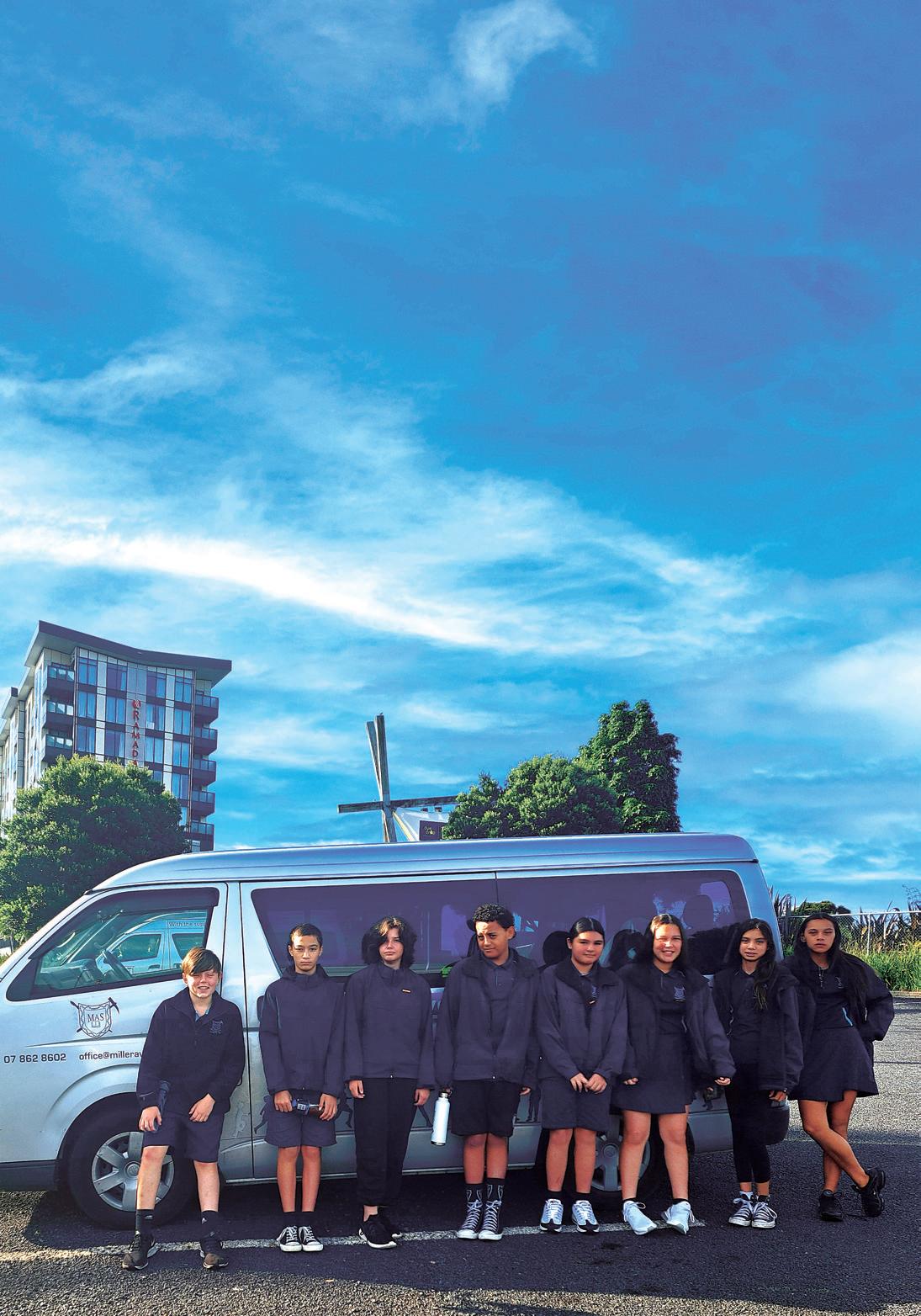
10 Education Gazette gazette.education.govt.nz
Student leaders attending a GRIP Leadership Conference in Manukau.
New approaches to attendance at Miller Avenue School in Paeroa have opened up channels of communication and allowed students to see staff as trustworthy people who can and will support them.
“It starts with the children and ends with the children,” says principal Deborah Eastham.
Deborah (Whaea Debs) is a first-time principal, but a natural leader with the compassion and foresight that Miller Avenue needed.
Whaea Debs hopes her first role as a principal is also her last – simply because she couldn’t imagine leaving her current school, its students, and the Paeroa community she has come to regard as whānau.
Since June 2022, the policies and changes prompted and rolled out by Debs at Miller Avenue have brought noticeable and positive change to the school’s culture and reputation.
From Papatoetoe to Paeroa
As the 2022 winter settled in, Whaea Debs enthusiastically packed up her belongings and left what she knew to make a new home and career in the rural Waikato town, with her husband and two teenage daughters following in the bloom of spring and new beginnings.
At Papatoetoe West School, Debs had worked from being a classroom teacher up into the senior leadership team over many years. Within this time, she attended the National Aspiring Principals’ Programme (NAPP) which prompted her to enrol in a Master of Educational Leadership following recommendations from the programme facilitator.
Upon completion she realised her passion and ambition wasn’t entirely locked to the big city life, or a school with an ever-growing roll. So, halfway through term 2 in 2022, she started her journey at Miller Avenue.
“I really wanted to be part of a small community. Papatoetoe West at its biggest was 840 students – it was a really big school. I just thought I really want to be in
a smaller area, a community, because I’m a real people person, and I love chatting to people and meeting people and sharing things with others.”
Like many schools around Aotearoa, Miller Avenue experienced a tumultuous time during the pandemic. The school hadn’t had a principal for an extended period, leaving the school community and its vision in a state of flux.
Despite the small student body of 135, the school had difficulties maintaining and encouraging regular attendance and so the roll continued to drop at an unprecedented rate.
These circumstances didn’t discourage Debs, as she has never been one to shy away from a challenge. Growing up in a low socioeconomic environment, with many challenges in a family of five, she could relate to the experiences of many of the school’s students.
Debs is big on social justice, and her lived experiences and rise from hardship are tools she keeps on her belt to assist in facilitating change.
“I’ve been in that position where school was such an important place for me. I think that’s where my passion comes from. I really adored my teachers and believed they wanted the best for me.
“I want students to come here, and know that they are safe, they’re loved and cared for, and that people really want the best for them. I want them to feel that when their foundation is strong, they are well set up to feel success in their learning. That’s a very strong desire that I have for all students.”
He tāngata, he tāngata, he tāngata
Prior to even setting foot on Miller Avenue grounds, Debs undertook background research to garner an understanding of what was and wasn’t working for both ākonga and kaiako.
“I work on a strengths-based model and when I came in, I had no agenda. I said, ‘tell me about how you do this or that at Miller Ave School’.
11 Tukutuku Kōrero 24 April 2023
“A lot of processes and systems have been developed together; I prefer to work collaboratively. One of the big initiatives we implemented since I got here was positive behaviours for learning.”
Deborah Eastham
“I sat and met with every single person who works at the school and had a 45-minute hui with them. I asked what they loved about the school, what things they would like to implement if they could. They’ve been through a lot of changes with leadership. They’d had teachers coming and going. I think they were quite unsettled. So I made health and wellbeing one of my first things to look at.”
Debs asked teachers to provide students’ attendance and background information in a collaborative Google Doc she had created for each classroom. Despite the small school roll, the circumstances and backgrounds of students were diverse, and so a standard one-sizefits-all approach would be unsuitable.
After analysing the data collected, she sought to implement the most appropriate and individualised initiatives that would assist each student and their whānau, and thereby teachers.


“It’s about building those relationships so that they know, ‘you’re a part of this’.
“It’s a three-legged stool; all of us need to be supporting each other, otherwise the child won’t be able to balance… so it’s about every teacher doing that.”
Debs felt it was important for the school to work more closely alongside whānau and community. Her meetings with parents were productive in understanding possible deficits in how the school went about facilitating student engagement, and even the out-of-school circumstances that posed barriers to regular attendance.
Debs says this was achieved through an open door policy, and taking the time to have those conversations.
“A lot of processes and systems have been developed together; I prefer to work collaboratively.
“Along those lines is getting them to school. There’s a school van that will collect children. At the moment the parents are paying, it’s not a huge amount, but I would like to get funding for that. That would be amazing.
“We’ve got a new caretaker who’s doing three rounds a day, so that’s helping get our kids to school. That really is a win for us. It’s about ‘what are the barriers?’ and how can we support the parents to make it happen for them.”
Engagement through wellbeing
Attendance tracking continued throughout the rest of the 2022 school year to pre-empt decreased attendance and address it at the earliest convenience. It also served as positive reinforcement for students whose attendance and engagement had noticeably increased.
“Around 23 percent of students were attending school 70 percent or less (chronic absences) in terms 1 and 2. By term 4, that had reduced to seven percent. I could share that back and say, ‘Actually, you are making some progress here, that’s great, keep going!’.
“If you just share all the negative stuff, then they end up getting downhearted and thinking, ‘I’m not
12 Education Gazette gazette.education.govt.nz
Nelly and Oscar working on cake recipes and baking.
making a difference, so why even bother’.”
As daily attendance rose, Debs began to consider how the school could keep students engaged, happy and comfortable while on site. In accordance with that goal, this year they launched a Life Skills for Mental Health and Wellbeing programme run by an external facilitator.
An objective of the schoolwide programme is to teach and support ākonga in recognising and expressing their emotions, with Debs saying self-regulation is an important skill for students to learn.
Some of the mechanisms implemented have been deep breathing exercises, a class hīkoi in the morning, and emotional intensity ratings.
“We were getting students coming into school upset and then things would kick off from there. We’re teaching them a ‘one to five’, where they can use their fingers to rate their feelings. It’s basically about supporting them to be aware of how they’re feeling, and if they’re feeling that way, what sorts of things they can do.”
Participation is not limited to students. Staff are actively encouraged to use these tools themselves, which then promotes regular use around the school.
“What’s great about it is that we can do it with the teachers as well. The other day a staff member came in, and was all worked up. I asked, ‘Are you a five? Are you a four?’ and they kind of laughed but then tried a strategy.”
Prior to the official start of term 1, teaching and support staff met to go over the programme.
“We drew pictures and coloured in on a gingerbread person how we think a rating of ‘one’ would look. Then we did ‘three’, then ‘five’.”
Positive reinforcement
Principles of restorative justice are valued by Debs, and she sees them as integral to keeping children afloat and out of conflict. After delivering a high number of standdowns last year she sought to move away from punitive responses to behaviour. She hopes that initiative and affirmative action at early stages will curb any major incidents.
“It’s about setting them up for success from that foundation. If they’re feeling supported, if they’re happy, then that learning can take place and they can love coming to school,” says Debs.
Alongside the health and wellbeing programme, the school has used initiatives from Positive Behaviour for Learning (PB4L) to promote belonging. Systems like the Choices Board involve rewarding good mahi and behaviour. Students receive tokens and at each token milestone their achievements are acknowledged.


“They get arm bands, they get Milo with a friend if they get 30 points, all that kind of stuff.
“The first child has nearly got to 100 on their tokens. That’s where they get a Principal’s Award, an acknowledgement letter sent home, and a special mention in the newsletter. They also go on the roll of honour for the term where their name is displayed out front and they can decorate their own name card. We want to push the positives.”
13 Tukutuku Kōrero 24 April 2023
Pania receiving the first of many 'Principal Awards' acknowledging students showing school values.
Lachlan, Taylor and Bronson choosing to read during break time.

14 Education Gazette gazette.education.govt.nz
“It’s a three-legged stool; all of us need to be supporting each other, otherwise the child won’t be able to balance.”
Deborah Eastham
Nelly, Torino, Dreous, Marlee and Marcielle enjoy learning in Waipuna-ā-rangi (Room Seven) .
No school is perfect, and unsurprisingly there are still some incidents – albeit less frequent – that need to be dealt with quickly and seriously.
“We’ve had to draw a line in the sand and stand students down for vaping and things like that. We’re kind of just trying to say, ‘We have high expectations here and that’s not OK’.
“This is what I tell everyone I meet – it starts with the students and ends with the students. We always need to be focusing on that.”
Agency in leadership
Behind the scenes Debs has frequent meetings with staff, both in large groups and individually. After an extended period of inconsistent leadership and uncertain values, Debs wants to ensure staff are not only on board with new processes but to check how they are keeping up with the changes.
“They’ve actually done really well, the staff. There’s a lot of new things to take on board and I can already see such a big benefit with the students.”
All senior students are seen as essential in demonstrating and promoting school values of hard

Bachelor of...
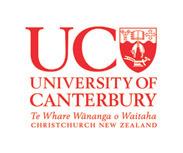
mahi and positive behaviour. They have great influence over the conduct of younger students – as much as the official rules and authority of teaching staff.
Until this year, the Miller Avenue student leadership group, made up of select Year 8s, was known as the student council.
Debs was not fond of the council term and wanted to assign titles that reflect each student’s achievements in reaching such standing. At the beginning of the year, the roles were rebranded.
“I’ve started fresh, they are now ‘student leaders’. I’m going to meet with them fortnightly and we’re going to talk about different events and how we can make our school better. They’ve got their own badges which we will present formally in assembly.
“The other day I got them in my office to show them the badges. You should have seen their faces, they were so blown away to get something really nice and personally named. It’s those little things that make the difference.
“I’m hoping when they stand up there with their badges, other students will look and say, ‘Wow, I want to be that person’.”
15 Tukutuku Kōrero 24 April 2023
A r ts AROHA Ambition Choose Arts at the University of Canterbury for endless possibilities! Unlock vast career opportunities with an Arts degree! Employers are seeking graduates with critical thinking skills, deep cultural understanding, and exceptional communication expertise – all of which you can gain through a Bachelor of Arts. With a range of degrees available, you can tailor your studies to your passions and aspirations, creating a degree that's unique to you. attitude Agility ACTION Scan the QR code to learn more, or visit: canterbury.ac.nz/arts
 Reg Blake is tumuaki at Te Kura Kaupapa Māori o Otepou.
Reg Blake is tumuaki at Te Kura Kaupapa Māori o Otepou.
Tauira to Tumuaki Reg Blake gives back to his kura in Tauranga
Reg Blake was a student at Te Kura Kaupapa Māori o Otepou –a small school in Welcome Bay, Tauranga – from 1996 to 2002. Eighteen years later he returned to the kura as tumuaki, to give back to the community.
The walls at Te Kura Kaupapa Māori o Otepou are the same walls Reg Blake would stare at when he was a student at the kura 18 years ago.
Standing in that same school as tumuaki now, the bricks on the ground, the green doors and the carpet evoke memories for him.
“When I stand here today, I look back at how many people have given to the kaupapa. I think of those who used to sit on the paepae here and they’re now laying at the urupa down the road from us.
“I draw my kaha and I draw my energy from those who have passed on,” he says.
Reg says it was the norm for Kaumātua to turn up to the many kaupapa when he was a student. One of his fondest memories is seeing the paepae full of those Kaumātua.
“Now it’s me and a couple parents who have to man the paepae because our Kaumātua are stretched in our rohe,” he says.
Reg left Te Kura Kaupapa Māori o Otepou in 2002 and attended Te Kura Kaupapa Māori o Te Koutu in Rotorua for a year before returning to Otepou to attend wharekura and later attend Te Kura Kaupapa Māori o Te Kura Kōkiri.
“Otepou set the foundation and I will always pay homage to my teachers of my years when I was there, where each had gifted me some type of skill or some type of something that I am able to today put into fruition or put into action,” he says.
A long ride
When asked how old he was when he realised he wanted to become a teacher, Reg laughs.
“To be honest, I did not want to be a teacher. When I say we were chucked in the deep end – I really mean that.”
Straight out of kura, Reg and about 11 others went for “a ride” in a van. They didn’t know where they were going, or how long the ride would be until they arrived in Ōtaki – home to Te Wānanga o Raukawa.
“We had no bags, we had no blankets, we didn’t even know what we were up to until the driver goes ‘right we’re staying here for the weekend and you’re starting your teaching course’.”
Reg says although teaching is not what he wanted to do at that time, he is “truly grateful” to Te Kura Kōkiri for recognising there was a need
17 Tukutuku Kōrero
MĀORI-MEDIUM EDUCATION
“The community is part of the bigger picture of helping to raise our tamariki. If I’m going to build resilience among our tamariki, I’m going to need help and assistance from the community.”
Reg Blake
for kaiako Māori. He says this is what kept him going during his studies.
“I just kept reminiscing on the people that did the long fight – those who are still fighting today for the benefits of tamariki Māori.”
Reg laughs as he retells that story, but adds, “look where I am today. So, I kind of pay homage to that humble beginning.”
Reg finished his teaching degree in 2010 and graduated in 2011. He spent a year teaching at a kura Māori in Temuka, a small town not far from Timaru in
South Canterbury, before returning to Te Kura Kōkiri to teach for eight years.
On 12 June 2020 – his late dad’s birthday and 24 years after he started at the school as a student – he became tumuaki of Te Kura Kaupapa Māori o Otepou.
More than a J.O.B
Te Kura Kaupapa Māori o Otepou is home to 74 students and eight staff including Reg.
Much like the story of how he became a teacher, Reg initially did not want to become a tumuaki.
Education Gazette first met Reg Blake as part of a video on learning in local contexts in Tauranga Moana. Watch Reg and his Te Tai Whanake ki Tauranga Moana Kaitiaki Group colleagues at youtube.com/edgazettenewzealand.

18 Education Gazette gazette.education.govt.nz
“My long-term vision is our community is a reo-Māori speaking community by 2030. My vision is that our tamariki, who will be young teenagers come 2030, will be sitting on the paepae, with their nan and koro doing their waiata tautoko.”
Reg Blake
“I’m more of a ‘do the mahi, put in the hard yards’. I don’t care about titles, and I don’t care about the pay scales,” he says.
But the staff at the kura had been encouraging Reg, who has been the kapa haka tutor since 2018, to learn the principalship with the goal of taking over.
When the tumuaki position became available, Reg applied with the support of Te Kura Kōkiri and his whānau. He was shortlisted and after an interview he was offered the position of tumuaki.
“I had to go back to my whānau and say are you ready to support me? Are we ready to sign our whānau into this knowing that we are here not on a J.O.B agenda but a lifestyle agenda?”
Giving back to the community
“It takes a village to raise a tamaiti,” says Reg.
It took a village to raise him and now, as tumuaki, he is trying to bring that pedagogy back to the kura.
“I let the whānau know they also have a voice in how our kura is governed and how our kura is run. The Board is just an entity that looks after the kura.
Free online energy related STEM resources






• Engaging and easy to follow resources on renewable energy.
• Designed by teachers and aligned to the NZ curriculum.
• Educational online games suitable for individual or class learning.

Find out more at schoolgen.co.nz/teachers
But really whānau, you have a huge say.”
Reg says he had to do a lot of repairing when he took on the role as tumuaki, rebuilding relationships with the hapū, iwi and community.
“The community is part of the bigger picture of helping to raise our tamariki. If I’m going to build resilience among our tamariki, I’m going to need help and assistance from the community.”
Reg says now the kura is called upon for many kaupapa, and his students are not only ready – they are excited. He says seeing that passion in his tamariki has been special.
“It’s my way of decolonising the tamaiti, to try and be Māori before anything.”
Reg has big dreams for the kura and its community.
“My long-term vision is for our community to be a reo Māori speaking community by 2030. My vision is that our tamariki, who will be young teenagers come 2030, will be sitting on the paepae, with their nan and koro doing their waiata tautoko.”
Reg says he is extremely thankful to the current and past members of Te Kura Kaupapa Māori o Otepou Board for their continued support and guidance.
Overview Learn about the Sun’s position in the sky throughout the day, how Earth rotates and how a sundial works to show the time. Curriculum links: NZ Curriculum Sundial time LEARNING AREAS ACHIEVEMENT OBJECTIVES LEVELS YEARS Science: Planet Earth and Beyond: Astronomical systems Investigate the components of the solar system, developing an appreciation of the distance Physical world: physical inquiry and physics concepts Explore, describe and represent patterns and trends for everyday examples of physical phenomena, such as movement, forces, electricity, light, sound, Mathematics: Geometry and measurement; measurement Use linear scales and whole numbers of metric units Overview This activity assists teachers and students who are new to coding to get started with block coding or programming. Students can create simple code, choosing a digital sprite/character and using block instructions to make it move. Curriculum links: Block coding for beginners LEARNING AREAS ACHIEVEMENT OBJECTIVES LEVELS YEARS Technology: Designing and Developing Digital Outcomes (DDDO): Progress outcome authentic contexts and taking account of end-users, students participate in teacher-led activities to develop, manipulate, store, retrieve and share digital content order to meet technological challenges. doing so, they identify digital devices and their purposes and understand that humans make them. They know how to use some applications, they can identify the inputs and outputs of system, and they understand that digital devices store content, which can be retrieved later. Years 3-8 Overview Learn about why the Sun is so important. Investigate the Sun’s heat and light energy and how it influences people Earth. Curriculum links: NZ Curriculum Our Amazing Sun LEARNING AREAS ACHIEVEMENT OBJECTIVES LEVELS YEARS Earth and Beyond Astronomical Share observations about the and their physical effects the heat and light Earth. Nature Investigating in Extend their experiences and personal explanations of the world through exploration, play, asking questions, and discussing simple models. 19 Tukutuku Kōrero 24 April 2023
Cyclone response takes home-schooling to new level

20 Education Gazette gazette.education.govt.nz
the
of
the
to form community
no other,
for
in the rural area of Dartmoor
found themselves completely cut off and in need of a new place to learn.
From
destruction
Cyclone Gabrielle came
chance
bonds like
including
those
who
CYCLONE GABRIELLE
The pioneering spirit came into play when a boat and pulley system was used to cross the Mangaone River after the cyclone tore the bridge down on 14 February.
Six days before Cyclone Gabrielle hit Hawke’s Bay on 14 February 2023, outreach teacher Roxy Hickman wrote in her diary, “I need something to focus on.”
When access to Puketapu School, west of Napier, was severely restricted by downed bridges, slips and new lakes, Roxy’s focus turned towards making her home a classroom for the now isolated students in the community.

“The area around Puketapu was obliterated,” she says. “It was like a war zone.”
As with many cyclone-hit areas, Dartmoor lost power and access to the internet.
“We were cut off. We had a community meeting. A lot of adults spoke about tragedy and of being cut off. I looked around and thought these children need to have a little time for themselves, for them to be kids, to learn together and to play.”
Roxy and her partner Greg had moved relatively recently into their upper Dartmoor home but a major slip and flooding meant they could venture no further than five kilometres in either direction for two weeks.
Children who lived in the area, but went to school in Puketapu and Taradale, couldn’t get out. Roxy saw the need for children and teens to have their own time to be together, and have a regular routine, and she set about to make that happen.
“I set my house up as a classroom. The house is open plan so we had an area for little children, a dining room table for middle school students and a barbecue table outside for secondary school students. Everyone has a place here.”
A school is born
In its first week, the newly created Dartmoor School opened its ranch-slider to 21 students from early learning through to secondary school. Teaching resources were helicoptered in.
“Te Mahau of The Ministry of Education has been awesome,” says Roxy. “They asked ‘what do you need, what can we do to help?’ It was amazing.”
Otairi Homestead loaned the school a generator. With power they were able to connect to the outside world via Starlink internet.
21 Tukutuku Kōrero 24 April 2023
“The cyclone is not a situation anyone wanted to be in, but it has allowed us to be part of an amazing community.”
Alice Beamish
Ben in his cowboy hat is pleased with his work in constructing a bird feeder.
“I saw that as important for teens particularly. Parents were able to contact family and friends to say they were safe, but there was no opportunity for teens to connect with their friends. It’s important for them to do this. I talked with each one of them to see if they’d connected with friends.”
Food was provided each day from donated goods which meant parents had one less thing to think about each day, says Roxy.
“It’s good for children to have a break and it gives parents a break too.”
As access to the outside world improved, first with a boat to transport them across the river, then a walking bridge, children began gradually returning to their schools.
“We have 10 to 12 students now, mostly younger ones –it’s such a big deal to get to school. I think I will miss having them coming in. It’s been nice getting to know them. It has been an absolute pleasure being able to informally develop a learning space for these children.”
For one activity, Roxy used the aftermath of the cyclone as the theme for a Lego challenge. Dartmoor School students across all age groups were to build Survivor Island.
“They needed to create a source of water and electricity. They built wind turbines. Some students built a Lego plane and flew generators from one island to another. Their conversations were absolute gold.”
Building bonds
Although Alice Beamish and her family had moved to Dartmoor only seven weeks before the cyclone hit, she willingly took on the essential role of keeping students fed and watered.
“I’m a lunch lady,” she laughs. “We say that with tongue in cheek.”
Alice’s five- and eight-year-old children had only just started at Puketapu School so they joined other children at Dartmoor School.
“For our children, the experience has helped them to build bonds with the community’s school children.”
Now they are back at Puketapu School two days week, they love to see other Dartmoor School students there, she says.
“The cyclone is not a situation anyone wanted to be in, but it has allowed us to be part of an amazing community,” says Alice.
Also helping in a support capacity at Dartmoor School is mother of three Ashlee Sullivan, who works with the school’s younger children.
The Dartmoor school brought some normal, some routine, to children’s lives during a difficult time, she says.

“Adults go into survival mode. Children feel the same in their own way so it’s good for them to be together and support friends through it all.”
The experience has created life-long connections between all people in the Dartmoor community, says Roxy.
“It’s been an interesting roller-coaster. Being disconnected has made us more connected. I want to thank Chris Fox and all of the teachers from Puketapu School for their dedication and support, especially Mel Leach and Baz Hodgetts who made the trip out to see the children.
“They are going through so much on the other side of the crossing, yet they find the time to check in on how we are going.”
As for Roxy’s 8 February diary entry – she got what she wished for, but her adventure came in an unexpected way.
“I feel like I’ve been overseas somewhere,” she says. “I’m looking forward to connecting with my outreach teams now. And getting back to that normal routine.”
22 Education Gazette gazette.education.govt.nz
Mason draws and writes about his face-to-face encounter with a big fish at an aquarium. He enjoyed his time at Dartmoor School, saying "I got to know the other kids on our road."
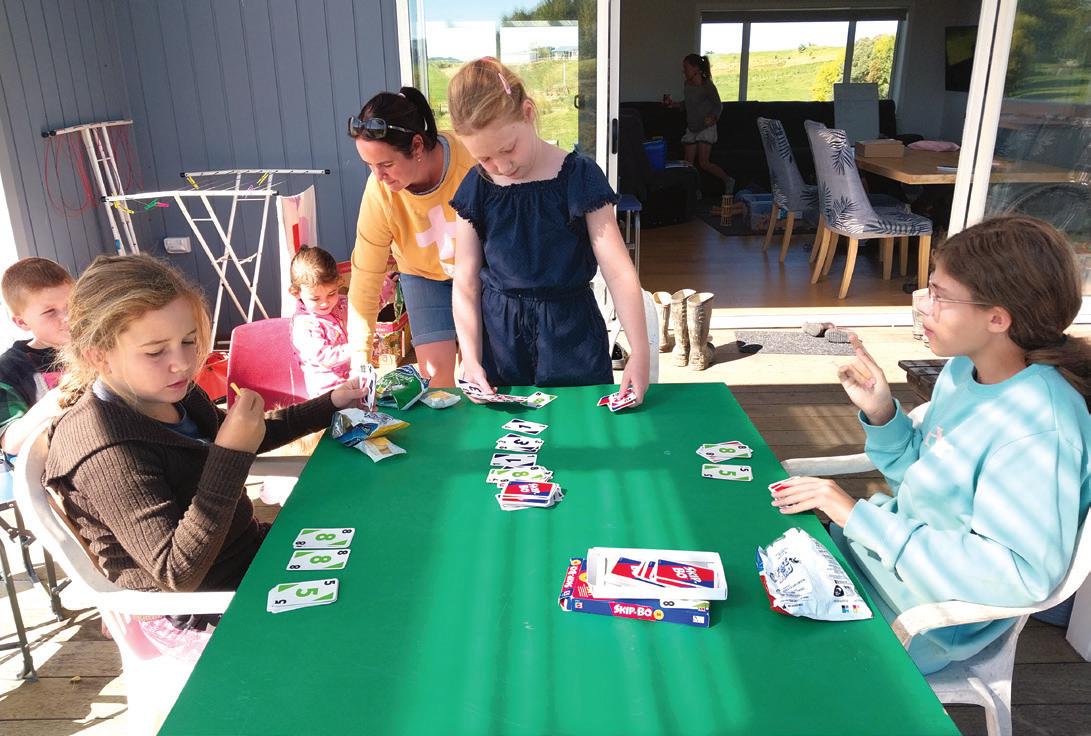
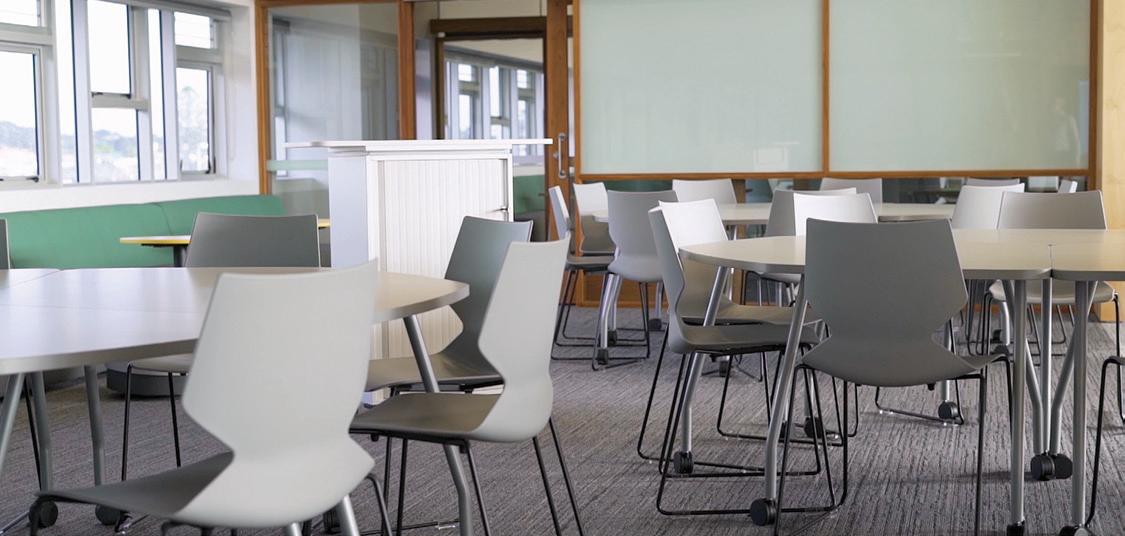

23 Tukutuku Kōrero 24 April 2023 “It’s been an interesting roller-coaster. Being disconnected has made us more connected.”
Roxy Hickman
www.smartofficefurniture.co.nz Furnishing Classrooms since 1996 sales@smartofficenz.co.nz 0800 376 373
Aria, Nicole and Isla enjoy time together with snacks and the sequencing card game Skip-bo.
He Ara Tika Ākonga embrace the pathway to success
A Senior Pathway Programme at Rotorua Lakes High School is proving transformative for ākonga who were disengaged from school. The approach gives ākonga agency, builds inclusivity through whanaungatanga and manaakitanga, and empowers them to succeed.
Walking into the Senior Pathway Programme learning space at Rotorua Lakes High School, there’s a buzz among the students, who along with their kaiako and mentor Moe Tansey, are brainstorming about designing their dream home.

The house they envisage building together is as big as their dreams for the future.
This is a success story playing out in real time – a year ago, these students were disengaged, unmotivated and not achieving at school, struggling in a system they felt invisible in.
Now, they’re at school, engaged and eager to learn, not because they have to, but because they want to.
Rotorua Lakes High School principal Jon Ward is a realist when it comes to what he believes is causing disengagement among his school’s most vulnerable students.
Jon is proud that his school has always been very good at getting academic outcomes. But he’s also critically aware of the fact that for some students, his school just isn’t a cool place to be.
Covid and a whole lot of other things have contributed to this, he says, but Jon is also a solutions man, who doesn’t like to waste time dwelling on the negatives.
“The question for me was not what caused this, but how do we solve it?”
24 Education Gazette gazette.education.govt.nz
ATTENDANCE & ENGAGEMENT
Kaiako and mentor Moe Tansey with students from the new Senior Pathway Programme at Rotorua Lakes High School.
A new approach
Looking at the number of students that were “disappearing” at a senior level and what to do about it, isn’t anything new at Rotorua Lakes High School or any other secondary school for that matter, says Jon.
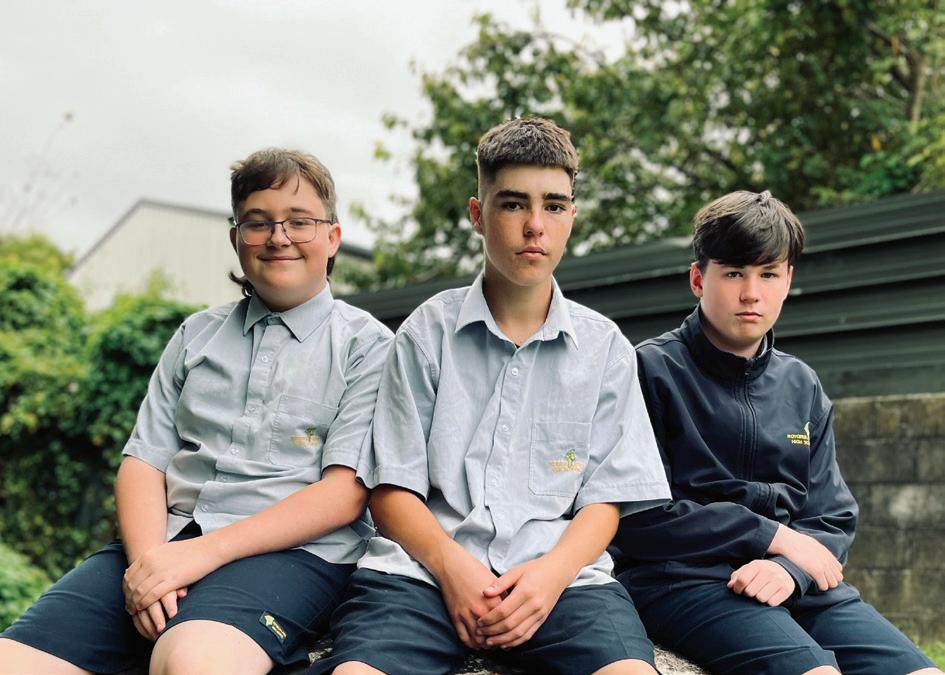
Discussions around these issues have been ongoing, but the harsh reality for his school was looking at “a new and very different approach”.
And whatever that new approach looked like, it needed a collective effort, with buy-in from the school, whānau, the community and local mana whenua.
The Senior Pathway Programme at Rotorua Lakes High School is being implemented for the first time this year and has been specifically tailored to re-engage and empower a group of 17 Year 11 and 12 students.
A team of passionate educators at the school, led by deputy principal Pani McLean and including learning support coordinator AJ Harris, and kaiako and mentor Moe Tansey, has been pulled together with one common goal – to help these students believe in themselves and respect others and their environment, while setting goals for the future.
Jon is honest about some of the challenges that they have had to navigate through to get the programme off the ground.
Things had to be done properly including having a designated learning space where the students felt safe and ready to learn.
“Not everything went according to plan. There are some things that we really wanted to implement that have fallen through,” he says.
“Most of all, the ability to finance the programme will become an issue moving forward if we can’t secure the ongoing funding. I’m going to state that clearly from the beginning.”
But right now, with the programme in full swing and results already starting to speak for themselves, it is crucial to have a team leading the charge who have the flexibility to work around the issues along the way, says Jon.
25 Tukutuku Kōrero 24 April 2023
“That whakawhanaungatanga has been crucial … They need to feel like they are a part of something bigger than themselves.”
Jon Ward
Liam, Shelby and Brayden.
Reconnection and re-engagement
Each of the 17 students handpicked for the Senior Pathway Programme at Rotorua Lakes High School has their own unique story to tell.

Although their individuality and what works for them in a school environment is what is being focused on now, there’s a common underlying theme among them all – the feeling of not belonging at school.
With a smile from ear to ear, it’s hard to imagine that a year ago 15-year-old Liam wasn’t happy.
Being in a classroom caused him such severe anxiety, that he would often leave school halfway through the day.
In his own words, his attendance “wasn’t very good” and his parents wondered if he was still on the roll.
“It was really stressful, I wasn’t doing any full days,” he says.
But this year is different. Liam’s smile says it all.
“I’m here every day, and all day and I’m glad to be here,” he says.
Brayden, also 15, speaks openly about how much he
hated school. Last year, an average day for him looked like staying home and “gaming”. He was taken off the roll because of the amount of time he had off.
Without saying it out loud, Brayden felt invisible at school, he was drowning in a system that just didn’t work for him.
That all changed this year when he was selected to be part of the Senior Pathway Programme. This year, Brayden’s attendance is sitting at around 96 percent.
“I actually do work here. I feel like I’m achieving something.”
Their classmate Shelby says the only reason he attended school last year was because “he had to”.
“It wasn’t great, but I get a lot more help now.”
Building good relationships and having a sense of belonging and respect and pride in their environment and themselves, is at the centre of why the Senior Pathway Programme has been implemented.
AJ says even though it’s early days, the results are already becoming evident.
26 Education Gazette gazette.education.govt.nz
“It’s created this incredible bond, because there is ownership not only for themselves but for their classmates. They are coming here every day because they want to be here.”
AJ Harris
Rotorua Lakes High School principal Jon Ward and students from the Senior Pathway Programme.
Whanaungatanga
It’s the small things that speak volumes about how needed this programme, says AJ, like wearing the school uniform with pride and vast improvements in attendance.
There are opportunities to get a driver’s licence or look at study options at places like Toi Ohomai.
Students are encouraged to help in the community and to do what they can to contribute to looking after themselves and the environment.
“That whakawhanaungatanga has been crucial,” says Jon. “They need to feel like they are a part of something bigger than themselves.”
For most of the students going on to Year 13 is now a very real possibility. Each student has signed a twoyear contract – it’s not legally binding, but it gives the students accountability.
“It’s created this incredible bond, because there is ownership not only for themselves but for their classmates. They are coming here every day because they want to be here,” says AJ.
Paving the pathway forward
Jon’s interaction with students in the Senior Pathway Programme at Rotorua Lakes High School is fluid and effortless, which is rare when you think of the traditional model of authority in a school.
Respect is reciprocal – Jon, AJ and Moe, along with a myriad of others are genuinely and wholeheartedly invested in this programme.
AJ says being with the students in their learning space gives you a warm fuzzy feeling that can’t be adequately described without being there.
“If you know these students, you know how far they have come and I couldn’t be prouder,” he says.
The feedback they are getting from the students is enough for them to know that this programme is working.
However the question of where the funding will come from in the future continues to weigh heavily.
The school’s Board has made it happen this year, along with massive support from the Graeme Dingle Foundation.
“We are extremely lucky and greatly appreciate the support of our Board and others in the community who are behind this programme as much as we are. The reality is, we need to make this sustainable,” adds Jon.
A better future
In March, Te Tumu Whakarae mō te Mātauranga, Secretary for Education, Iona Holsted visited Rotorua Lakes High School to see their Senior Pathway Programme in action.
The school received a $30,000 Regional Response Fund towards their own financial contribution.
While there, Iona presented students with certificates for their first credits towards NCEA Level 2 for 2023.
Following the presentation of the awards students spoke openly with Iona about the improvements to their attendance, how they love their kaiako because she makes them feel comfortable and valued, and how the programme feels like whānau where they help one another and are in it together.
“The Senior Pathway Programme epitomises the presence, participation, and progress approach,” Iona said at the time.
Jon says there is nothing extraordinary about what they are doing at Rotorua Lakes High School. There are some fantastic programmes being rolled out all over the country.
He does, however, feel that the difference the Senior Pathway Programme is going to make will be glaringly obvious in years to come.
“We believe in what we are doing here. We are preparing these students for a better pathway and future.” mel@caxed.co.nz
AWARD WINNING MATHS TEXTBOOKS WITH
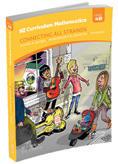
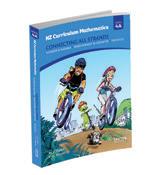



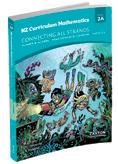



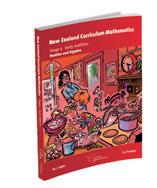


27 Tukutuku Kōrero 24 April 2023
www.caxed.co.nz
Give your students the best advantage to excel at maths. They use our textbooks, while you have all our free online teacher support. YOUR STUDENTS DESERVE THIS!
free ONLINE TEACHER SUPPORT
Finding flow turns attendance tide
A mighty project at a Waikato school strengthened confidence, motivation, and leadership qualities using a te ao Māori approach, and provided an enrichment experience like no other for 17 ākonga, with an impact deeper than imagined.


28 Education Gazette gazette.education.govt.nz
TE AO MĀORI
Te Pikikootuku participants take on a tree-top challenge.
The Waikato River provided a fluid focus for ākonga at Hillcrest High School – literally and metaphorically. A deeper understanding of the origins of this body of water only touches the surface of the rich learning absorbed by a group of rangatahi who formed the inaugural Te Pikikootuku project.
Project lead Tai Te Rito drove implementation of the programme, alongside then deputy principal of Hillcrest High School, Jarred Williams. The pair worked alongside the school’s head of Te Reo Māori Caseymia Hawkins, as well as Aroha Crombie and Nick Bryant of Te Roopu Whakaruruhau, focusing on Māori engagement and achievement.
Tai says selection for the camp and related activities was strategic, with several guiding factors being considered.
A total of 17 wāhine Māori students in Years 10 and 11 were chosen from 78 on the school’s roll.
“The focus was to get a mix of low academic performers, with low engagement, to highly engaged, high-performing students in leadership roles,” says Tai.
“The main objective was to increase engagement and attendance and to lift the performance of our female Māori students across the board.”
The initiative originated from the 2019 Regional Mentoring Project called Kaiwananga, which focused on Year 12 and 13 Māori students who were most at risk of not achieving NCEA.
Following the impacts of Covid-19, the re-tailored Te Pikikootuku project kickstarted this year based on
previous learnings. This programme added two optional assessment tasks to give students a head-start to NCEA – traditionally only offered to top band classes or gifted students, this aimed to break old mentalities for both ākonga and staff.
“Since Covid … a couple of girls had even stopped coming to school altogether. We wanted to do something to address this; something that brought people together to focus on growing and learning with one another and to create a better sense of unity,” says Tai.
Positive momentum
Ākonga embarked on a camp expedition, experiencing complementary learning activities, informal mentoring, and target tracking. With a ‘circuit breaker’ ethos, the programme hoped to create positive momentum among student collective, developing motivation and engagement in curriculum subjects on their return to school.
Te Pikikootuku uses te ao Māori as a unifying foundation. Finding a focus for the project that combined cultural and academic learning was down to Tai.
“After looking into different ideas, I chose to base the learning around the Waikato River... by following the river from its origins in Taupō ending up in Hamilton, taking in different points along the way.”
The group visited several locations along the trajectory of the river; places that illustrated how this is not simply a body of water but a taonga (treasure), a tuupuna (ancestor) and the mauri (life force) of Tainui and wider communities.

29 Tukutuku Kōrero 24 April 2023
“The primary focus of this kaupapa was to strengthen the confidence, motivation, and leadership qualities of our young wāhine using a te ao Māori approach.”
Tai Te Rito
Wāhine learnt about the concepts of kaitiakitanga and mauri, aligning with science and further enrichening their cultural understanding and sense of belonging.
On their travels, team-building activities prompted wāhine to challenge themselves in situations requiring varying amounts of courage. Jetboating along the river in Taupō was the most adrenaline-fuelled of the character-building opportunities.
“Being able to actually ride on the river – at speed – was one of the highlights for the girls. The jet boat trip was definitely an experience to remember,” says Tai.
Wāhine also visited Huka Falls with a local iwi leader to witness the force of the river, as well as the location of ‘terraces’ at Orākei Korako, where they engaged in a science lesson as a group.
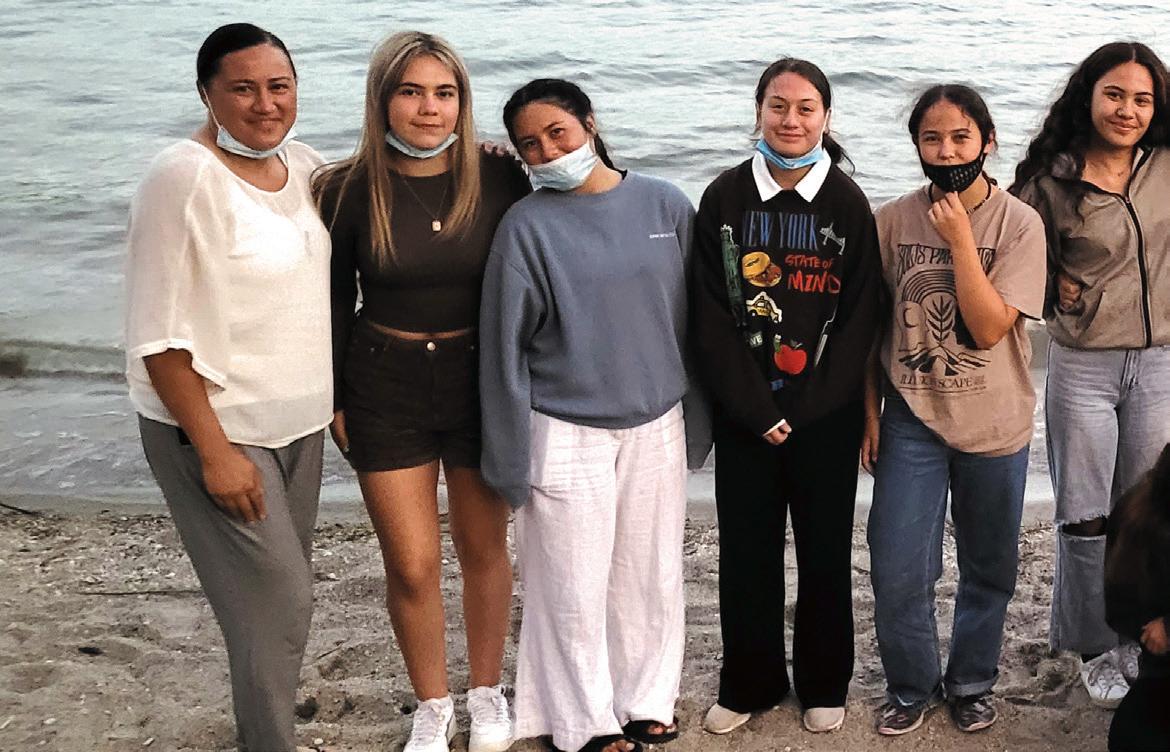
“The students gained a deep understanding of the relationship between Tainui and Tūwharetoa at Huka Falls and the history behind this, as well as the connection of the river to both iwi. There was so much character building along the way, as well as opportunities for the wāhine to learn more about their culture and about science,” says Tai.
Agency and leadership
Tai stresses the importance of expectations being communicated and clarified from the outset.
“An important part of pre-learning was getting everyone together as a group to give everyone an understanding behind what we were trying to achieve as a collective.”

Ākonga were given the chance to achieve NCEA credits during the programme, by taking up leadership opportunities. Tai was pleased that many did. And was even more pleased with some of the post-expedition outcomes.
“The primary focus of this kaupapa was to strengthen the confidence, motivation, and leadership qualities of our young wāhine using a te ao Māori approach, and in doing so, drive-up engagement and attendance, which I can safely say we managed to achieve.”
Te Pikikootuku did this, and more. Tai says ākonga responded really well to the camp experience itself, and their efforts and engagement transformed when they returned to the classroom.
“There were a couple of older students who were the self-nominated leaders of the group, if you like. Like many, they had the potential but were
30 Education Gazette gazette.education.govt.nz
Unity shone through team building and cultural learning along the Waikato River.
disengaged at school. However, one student went on to pass Level 1, gaining an excellence endorsement.”
Although in its first year in 2022, it is hoped the project will continue at the school, as well as providing a proven blueprint for other kura to follow.
Since last year, Tai has followed his former deputy principal Jarred Williams to Napier Boys’ High School, where the pair can look to their past success with Te Pikikootuku.
Become
“I live for that ‘aha!’ moment on my students’ faces!”
– Samantha, Cluey tutor
Become
all lesson plans created for you!
We are looking for tutors to join our team to conduct online tutoring sessions for primary and secondary students across New Zealand and Australia. If you
have a passion for English or Maths, and will be taking papers in these subjects, we want to hear from you!
Choose your own hours
All lesson plans created for you!
Do you share our strong belief that education changes lives?
If the answer is “Yes!”, we have the students and resources ready for you! Earn $30 an hour. Make a difference and have fun doing it!
Become
a tutor! Work from home!
Become
– Samantha, Cluey tutor
https://clueylearning.co.nz/become-an-online-tutor/
“I live for that ‘aha!’ moment on my students’ faces!”
We are looking for qualified teachers to join our team to conduct online tutoring sessions for primary and secondary students across New Zealand and Australia. If you have a passion for English, Maths, or Science we want to hear from you!
all lesson plans created for you!
We are looking for tutors to join our team to conduct online tutoring sessions for primary and secondary students across New Zealand and Australia. If you
– Samantha, Cluey tutor
Do you share our strong belief that education changes lives? If the answer is “Yes!”, we have the students and resources ready for you!
have a passion for English or Maths, and will be taking papers in these subjects, we want to hear from you!
all lesson plans created for you!
Earn $30 an hour. Make a difference and have fun doing it!
Do you share our strong belief that education changes lives? If the answer is “Yes!”, we have the students and resources ready for you! Earn $30 an hour. Make a difference and have fun doing it!
We are looking for tutors to join our team to conduct online tutoring sessions for primary and secondary students across New Zealand and Australia. If you

have a passion for English or Maths, and will be taking papers in these subjects, we want to hear from you!
Choose your own hours
Choose your own hours
Do you share our strong belief that education changes lives?
https://clueylearning. co.nz/become-anonline-tutor/

https://clueylearning.co.nz/become-an-online-tutor/
https://clueylearning.co.nz/become-an-online-tutor/


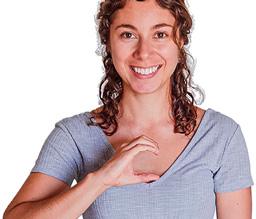

a tutor!
Work from home!
a tutor!
Work from home!
a tutor!
Work from home!
If the answer is “Yes!”, we have the students and resources ready for you! Earn $30 an hour. Make a difference and have fun doing it! “I live for that ‘aha!’ moment on my students’ faces!” – Samantha, Cluey tutor We are looking for tutors to join our team to conduct online tutoring sessions for primary and secondary students across New Zealand and Australia. If you Become a tutor! Work from home! all lesson plans created for you! Choose your own hours https://clueylearning.co.nz/become-an-online-tutor/
have a passion for English or Maths, and will be taking papers in these subjects, we want to hear from you! Do you share our strong belief that education changes lives? If the answer is “Yes!”, we have the students and resources ready for you! Earn $30 an hour. Make a difference and have fun doing it!
“I live for that ‘aha!’ moment on my students’ faces!”
31 Tukutuku Kōrero 24 April 2023
“There was so much character building along the way, as well as opportunities for wāhine to learn more about their culture and about science.”
Tai Te Rito
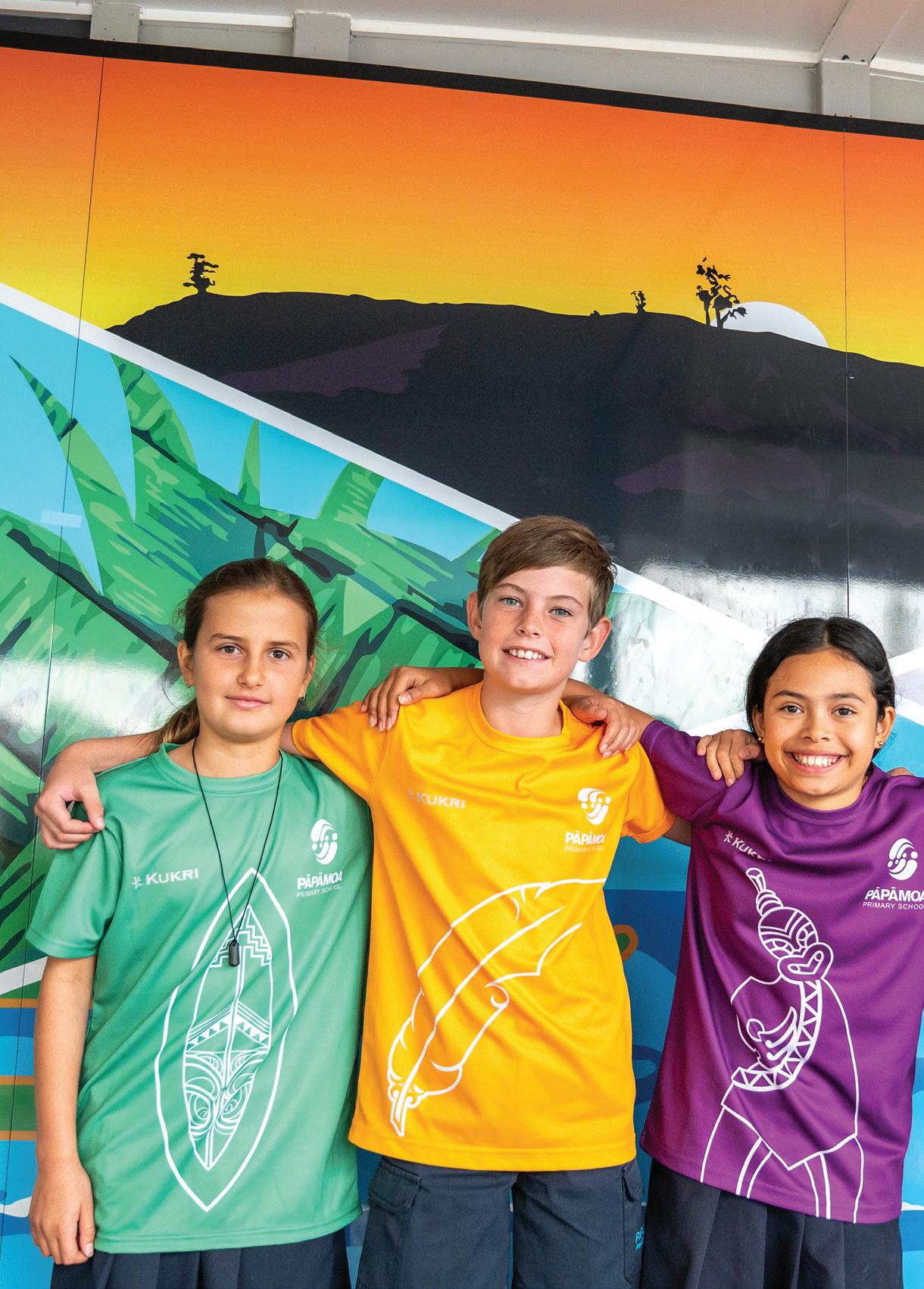 Year 5 student Lilah of Pou Uta, Year 6 student Benjamin of Pou Nui, and Year 5 students Maia of Pou Roa and Louie of Pou Tai.
Year 5 student Lilah of Pou Uta, Year 6 student Benjamin of Pou Nui, and Year 5 students Maia of Pou Roa and Louie of Pou Tai.
Ākonga find belonging and connection with Pāpāmoa Pou
A new school house system with te ao Māori at its heart is transforming a Bay of Plenty primary school.
Pāpāmoa Primary now has four Pou, explains pincipal Matt Simeon, known to the students as ‘Mr S’.
“Pou in Māori has a number of meanings. From a pole/post in the ground through to a mentor or expert. For Pāpāmoa Primary School, Pou means a group, a tribe, a gathering of people who strongly support a cause. Simply put, we say – my Pou is my tribe.”
Each Pou has its own unique story, values and colour gifted from local iwi Ngā Potiki. Pou Uta Guardian of the Land; Pou Roa Kaitiaki of the Pāpāmoa Hills, Pou Nui the cloak that wraps around everyone and Pou Tai the waka who brought everyone here.
All kaiarahi and tamariki were sorted into their Pou at a memorable assembly in the first few days of term 1 this year. Everyone that is, except for Mr S.
“I stand outside of the system to prevent the perception that the Pou points can be rigged. If this was Harry Potter, the Pou are like Ravenclaw and Gryffindor, and I’m a bit like Dumbledore.”
A sense of belonging
The Pou have become, as planned, a central part of the school community providing tamariki with a supportive network of peers and teachers.
“It’s about promoting teamwork, friendly competition, and a sense of community among tamariki and kaiako. The new Pou are a real source of pride and identity, they have enhanced the excitement and energy around the school and are fostering an even more positive and inclusive school culture,” says Matt.
Having been appointed to his new role at the beginning of 2022, Matt asked his staff for three great points about the school they’d never like to see lost, and three points they thought could be enhanced or changed.

33 Tukutuku Kōrero
TE AO MĀORI
“Nearly every teacher mentioned the house system as a thing they would like to see become a central part of the school.”
So, Matt met with local iwi and Kaumātua from Ngā Potiki.
“All the designs are quite specific to iwi. The first iteration was a Pa – Pa Uta etc but I sat with the Kaumātua, and he decided we needed four Pou to hold up a whare. There were a number of metaphors the Kaumātua used to highlight the Pou.
“The whole thing and our thinking evolved further following this kōrero. It’s been a great journey; a journey which has only just begun for the students and staff.”
School is a-buzz
The excitement around the Pou is palpable when talking to students, from loving their new T-shirts to be worn every Pou Friday or for any school sporting event such as cross country, or proudly understanding the meanings of their respective Pou and their responsibilities.
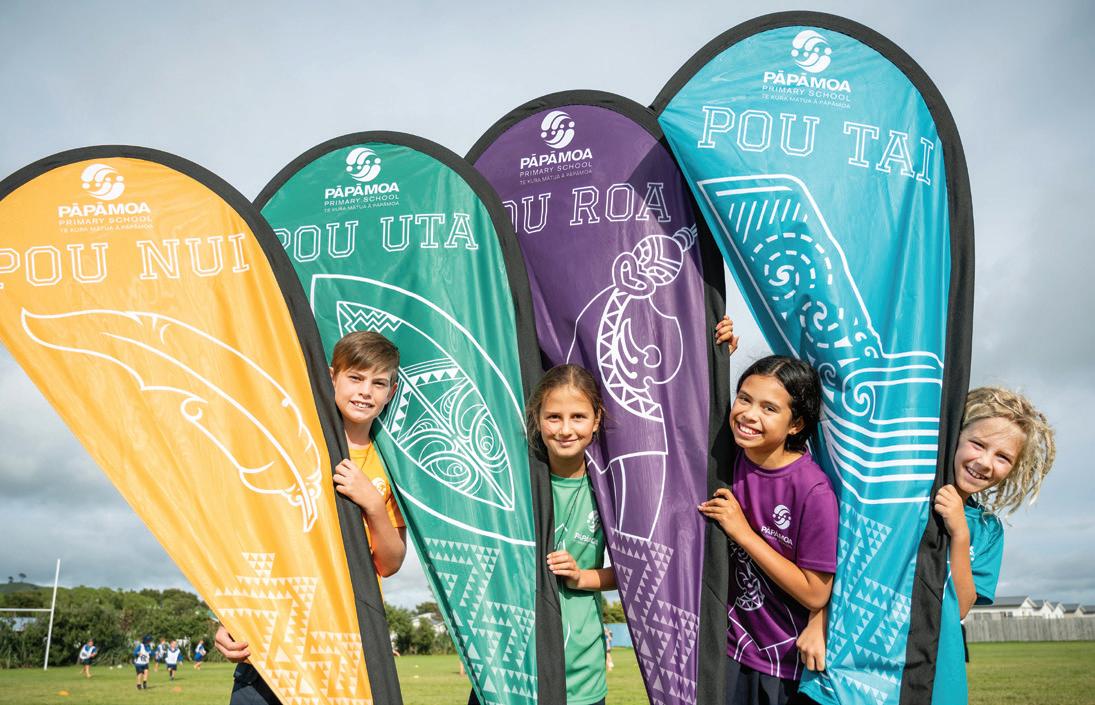
“Are we any good without the other?” asks Mr S.
“You have to have all four [Pou] to work. Without one of them we wouldn’t be here today, to have a competition, you have to have the others,” says Pou Uta’s Lilah of Year 5.
“And we’re singing better because we’ re trying to get Pou points,” says Pou Roa’s Maia, also Year 5.
“We were just colours before. Now we’ve been given new shirts which are better than Kmart ones, which we wear on Pou Friday, and we wear them at sports events,” says Pou Nui’s Benjamin, Year 6, who is also one of the school’s kaiarataki (leaders).
The students agree it’s given the school a real sense of unity, a sense of whanaungatanga.
“Now we’re part of our Pou and when we come together, we feel connected. We played games like what colour are your eyes so we can start to learn about one another when we’re together, and now we all sit together for assemblies and do our Pou chants. And we have to look after the
34 Education Gazette gazette.education.govt.nz
“You have to have all four (Pou) to work. Without one of them we wouldn’t be here today, to have a competition, you have to have the others.”
Lilah, Year 5
Ākonga have a sense of pride in their tribes.
nohi nohi (little ones) in our Pou,” says Louie from Pou Tai, and in Year 5.
The move to Pou and the reset to operating the school via te ao Māori lens is absolutely curriculum driven, says Matt.
“Not only do teachers now get to use Pou points as a learning incentive, but teachers are also using the Pou to direct school learning in the classroom. Every school year will now begin with a unit on the Pou, their connection to Ngā Potiki, and what they mean.
“And the banter in the staff room between Pou has been great to see and hear.”
And by a stroke of synchronicity, neighbouring Pāpāmoa College’s new principal Iva Ropati has introduced a very similar house system creating a pathway for children who will leave Pāpāmoa Primary to go to Year 7 at their local college.

Community involvement
Linda Munn, local Ngā Potiki artist and co-designer of the Tino Rangatiratanga flag, and Tukara Matthews collaborated in designing and creating the artwork/graphics that go with each of the Pou. This was done alongside a team of teachers who also had input into the process.
The four local businesses who sponsored the Pou were celebrated at the sorting assembly.
“The businesses were so keen and happy to be involved. It’s bringing the community back into the kura.”
News of the power of the Pou has spread beyond Ngā Potiki. Matt and the kura, are soon to host a group of principals from Tāmaki Makaurau who are travelling to Pāpāmoa to see the Pou in action.
The Pāpāmoa Primary Pou
Pou Nui is yellow and represented by the image of a feather alluding to the korowai of Ngā Potiki. The korowai gives protection, and each strand is woven into the very fabric of the whenua, tangata and whakapapa.
Pou Roa is purple and represents the purple skies seen locally with an image referencing the mountain range that sits with the lands of Ngā Potiki: the maunga are kaitiaki which offer protection to all who live there.
Pou Tai is ocean blue and is represented by an image of the tauihi/prow of a waka, making room for all who are on a journey of learning. The tauihi cuts through the water and ensures the journey is a smooth and fruitful one.
Pou Uta is green and features an image representing the landscape that is Ngā Potiki and the neighbouring whakapapa links to surrounding hapū-iwi. Its Poutama design represents the steps taken on a journey to learning.
35 Tukutuku Kōrero 24 April 2023
A Pou launch assembly was held on 1 February, with students proudly wearing their new shirts.

36 Education Gazette gazette.education.govt.nz
Digital technology tools are integral to education.
How schools can embrace better online safety and security
The third in a series of Education Gazette articles on Cyber Security, we explore how Network for Learning (N4L) can support schools to keep ākonga safe while thriving in a digital world.
The use of technology as a learning tool in Aotearoa New Zealand schools has grown rapidly over the last decade.
In particular, there was an acceleration in the use of technology by schools during the pandemic lockdowns, as schools moved their curriculum online and then instigated a ‘new normal’ when face–to-face teaching resumed. Technology will continue to evolve and offer new ways to support the learning needs of ākonga, but as the use of technology increases in schools, so too does the threat from cyber attackers.
Leading threat intelligence organisation Check Point Research reported last year that the education sector is now the most cyber-attacked industry globally, and that Australia/New Zealand are the most attacked regions in the world.
Therefore, it’s more important than ever for schools and kura to be vigilant about online safety.
Each school’s internet is connected by Crown-owned organisation Network for Learning (N4L), which partners with the Ministry of Education to deliver Te Mana Tūhono programme.
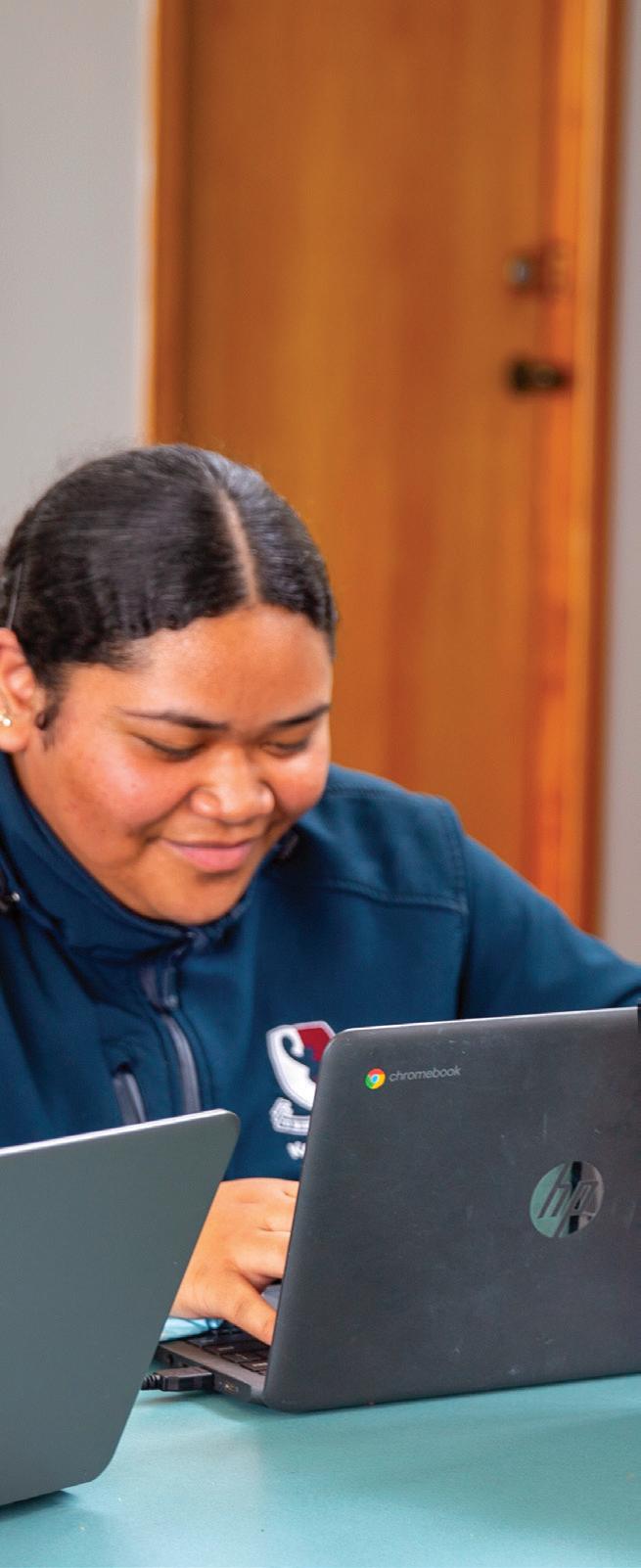
37 Tukutuku Kōrero 24 April 2023
SECURITY
CYBER
Strengthening defences
It’s never been more critical to ensure that schools and kura are as safe and secure online as possible.
Government agency CERT NZ’s latest quarterly report has listed phishing, scams and unauthorised access as the three top incident categories.
Keeping ākonga safe online is a team effort and everyone has a role to play. N4L can provide support with products and services that can help schools strengthen their defences against online threats, but technology on its own won’t protect schools.
It’s important that schools stay on top of their own cyber security, engage in continuous education for their kaiako and ākonga, and raise awareness of good digital citizenship.
Tools and products
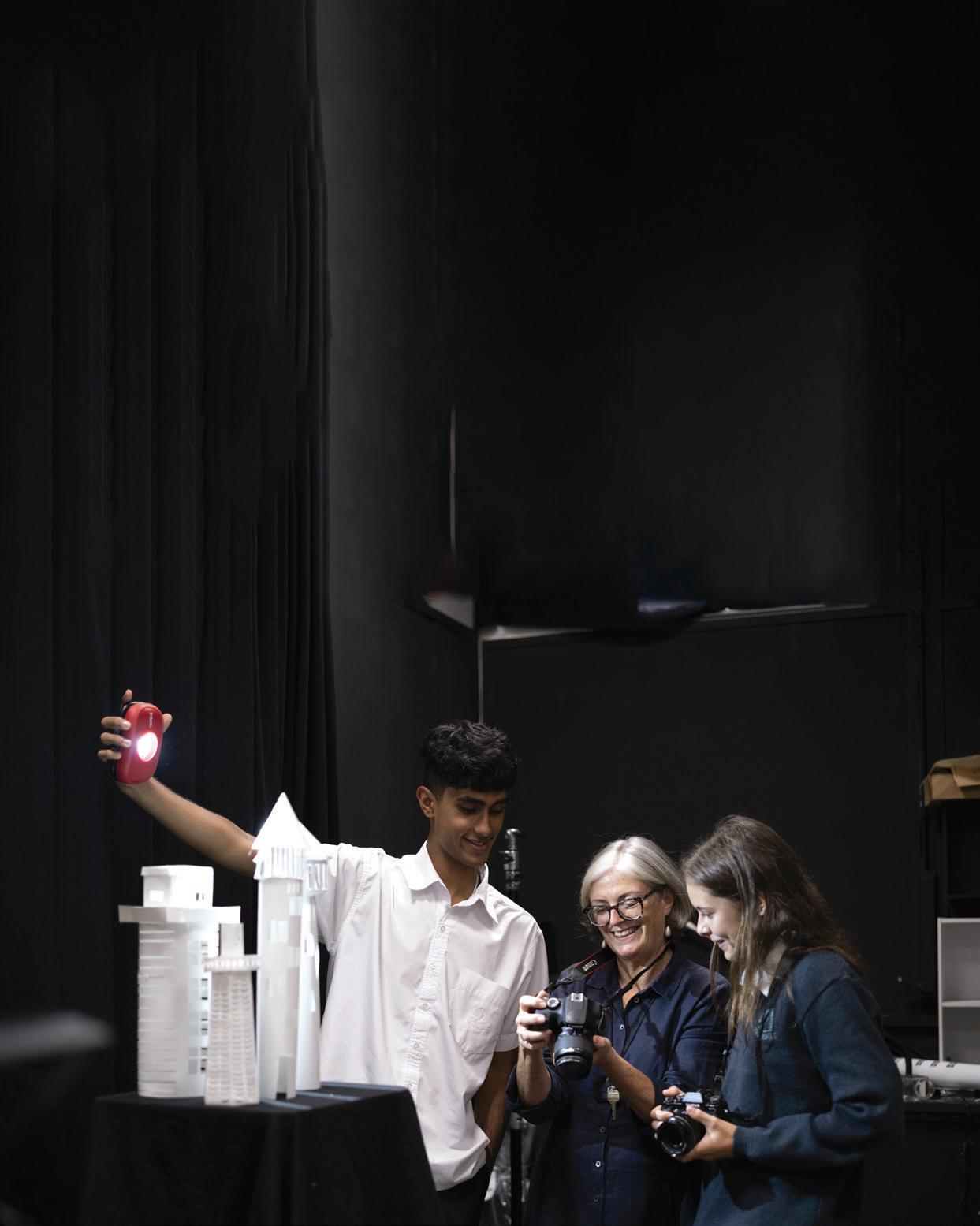
On a daily basis, N4L blocks over 600,000 cyber security threats targeting schools and makes 2.2 million website content blocks on the network.
To help prevent students from accessing online content that they shouldn’t, schools are able to block entire categories of content (e.g. explicit violence) and unwanted VPNs (Virtual Private Networks) that can allow students to bypass these settings. These filtering rules can be customised for schools by N4L.
Web filtering forms are part the Safe & Secure Internet service N4L provides schools, as part of the recommended settings, which also provides DNS (Domain Name Server) threat protection.
This helps block unsafe content and enables Google SafeSearch to filter out adult content in search results.
Safe & Secure Internet also offers some protection against
the impacts of Distributed Denial of Service (DDoS) attacks, which can cause an entire network to crash, preventing users (such as staff and students) from accessing resources on the network or the network itself.
Cyber attackers can exploit vulnerabilities in networks. N4L’s dedicated Cybersecurity Team proactively helps identify improvements to systems, monitor for irregularities or suspicious activity, and works with schools to help resolve or mitigate incidents.
During the recent holiday season alone (December 2022 to January 2023), 56.5 million emails containing known or targeted threats (such as malware and spam attacks) against school networks were blocked by N4L. If schools are concerned about the dangers of scams and phishing attacks, or a staff member or student unwittingly activating ransomware and malware through clicking on an email link they shouldn’t, Email Protection is a service that can help by proactively blocking dangerous emails.
Schools can help identify and control who is accessing their network and improve Wi-Fi security with Secure Access, which N4L is delivering in partnership with the Ministry. This provides different levels of access to students, staff and guests, and ensures that those who are accessing the network are the people who are meant to be.
How to get support
N4L are here to support schools and kura and they have resources such as Relationship Management teams across the regions and a national Customer Support team to help.
Support is available from the Customer Support team from Monday to Friday, between 8am and 5pm via support@n4l.co.nz or 0800 532 764.
38 Education Gazette gazette.education.govt.nz
Setting the scene – digital technology plays a key role across learning areas.
Check Point Research: ‘Education sector experiencing more than double monthly attacks, compared to other industries’, Check Point Corporate Blog, 9 August 2022
CERT
NZ – Quarter Four Cyber Security Insights 2022
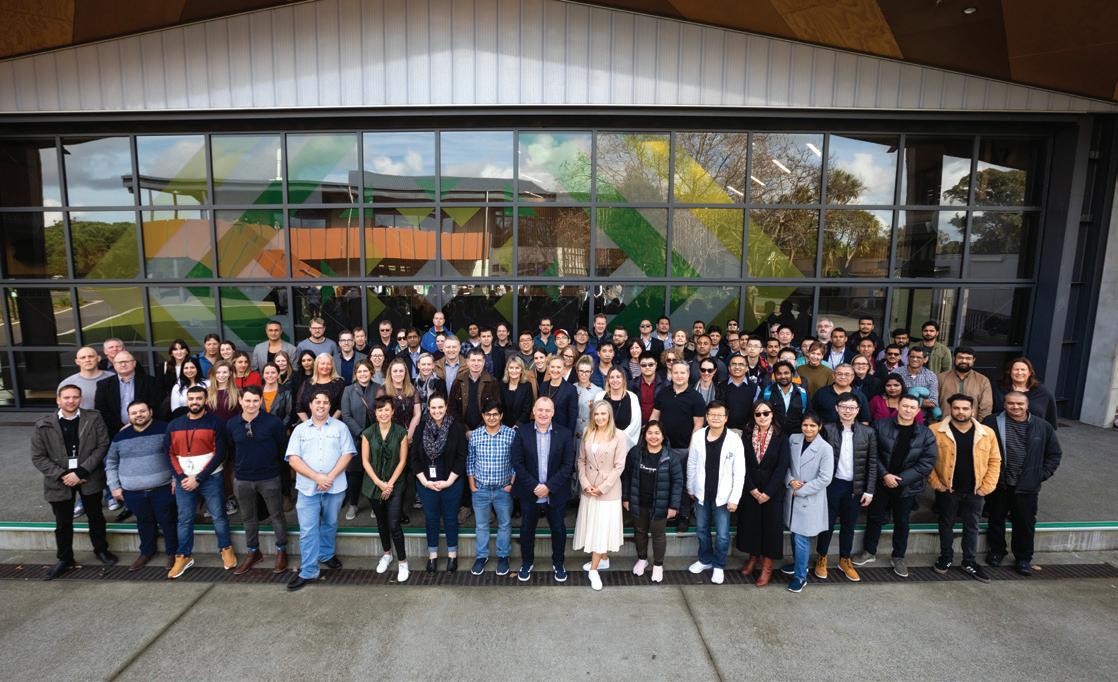
About Network for Learning
Network for Learning was established in 2012 by the Ministry of Education. Since then, they’ve been providing schools with access to faster, safer, managed broadband, Wi-Fi and cybersecurity services.

Today, more than 900,000 tumuaki, kaiako and ākonga enjoy daily access to a safer, more reliable online learning environment.
N4L operates one of the largest broadband networks in Aotearoa, accounting for 20 percent of daytime internet traffic across the motu.
For more information about N4L, visit n4l.co.nz
39 Tukutuku Kōrero 24 April 2023
Teamwork – working together to achieve great outcomes is key for cyber security and online safety.
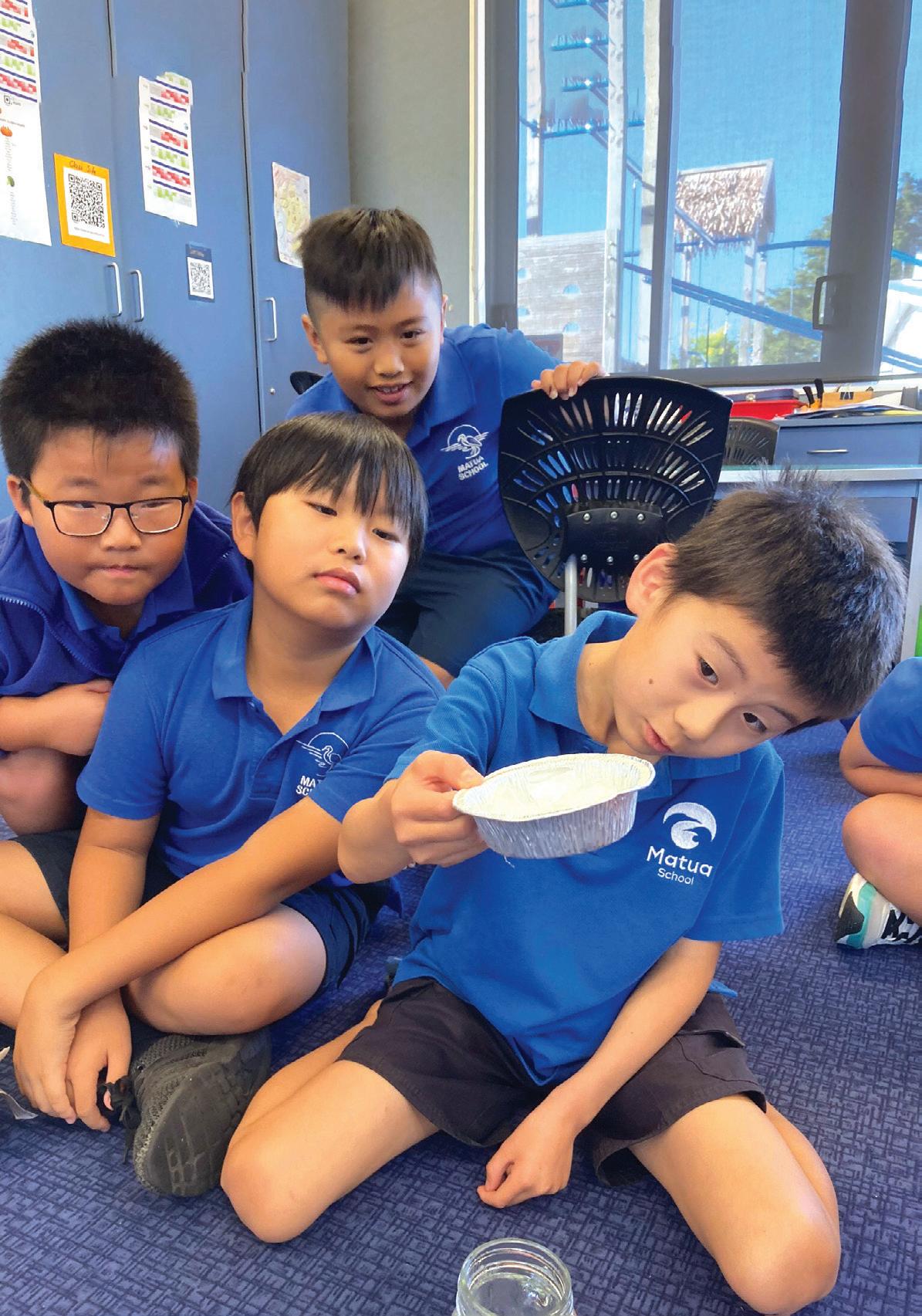
Ākonga at Matua School love engaging in science lessons.
Bilingual science kits give kaiako confidence
A team of New Zealand scientists has won a prestigious international award for their vast library of hands-on, bilingual science resource kits that enable thousands of primary school kaiako across Aotearoa to deliver life-changing science lessons.
House of Science NZ was chosen by the Royal Society of Chemistry’s (RSC) Horizon’s prestigious panel of judges as the winner of the RSC Horizon Prizes for Education.
The RSC receives applications from all over the world for their awards, which acknowledge individuals, teams and schools across primary, secondary, further education and higher education, for their exceptional contributions to chemistry education.
While the science kit concept was developed 10 years ago, with new additions and changes along the way, the recent award is testament to their value as a longstanding learning resource.
The development team, led by House of Science Charitable Trust resource developer Jane Hoggard, won the award for their contribution to making science education more accessible with last year’s kits.
Making science accessible
Combining the skills of eDNA experts, science communicators, educators and community engagement specialists, the group created the library of hands-on science resource kits to give teachers the tools and confidence to deliver interactive science lessons.
“I am proud of the work we are doing with both teachers and students throughout New Zealand, fostering wonder and curiosity in the world around us,” says Jane, who considers it a privilege to work alongside scientists to help create the kits for primary and intermediate schools.
Each bilingual kit (te reo Māori on one side, English on the other) includes up to eight different experiments on one topic.
The library includes 40 topics ranging from Climate Change to Flexi Physics and everything in between. Each kit has something for each age group, catering for Years 0–8.
The Electric Future kit, for example, includes an introduction to circuits using ‘energy tubes’ that light up; a discussion on what energy is and where it comes from; an activity to create circuits using batteries, LEDs and playdough; making a torch; making batteries; investigating solar powered cars in different light conditions; and making an anemometer to determine the windiest spot on the school grounds. The activities are sequential, each building on the preceding lesson.
House of Science says the learning outcomes for each activity are linked to the curriculum and are clearly outlined in the teacher manual.
41 Tukutuku Kōrero 24 April 2023
SCIENCE
“It’s of vital importance that we recognise the crucial role that educators play in the advancement of the sciences and that we commend their ability to inspire and nurture the next generation of bright young minds.”
Helen Pain
“We are strong believers in the power of hands-on activities to foster a child’s curiosity and grow their science capabilities,” says House of Science NZ CEO Chris Duggan.
Chris is a biochemist and former secondary school teacher who established House of Science because of a growing concern about the lack of science knowledge students had when arriving at secondary school.
“Tamariki articulate how they are gathering and interpreting data while working across the curriculum, and the whānau feedback has been positive,” she says.
“Children are telling their whānau that they act and think like scientists when doing everything from reading and solving maths problems, to gardening and exploring their local environment.”
Time-saving science
Every second week for the past nine years, Matua School science specialist teacher Bruce Reid has used the fully stocked science resource kits containing all necessary equipment, consumables and instructions to tackle high-interest science topics that the children love.
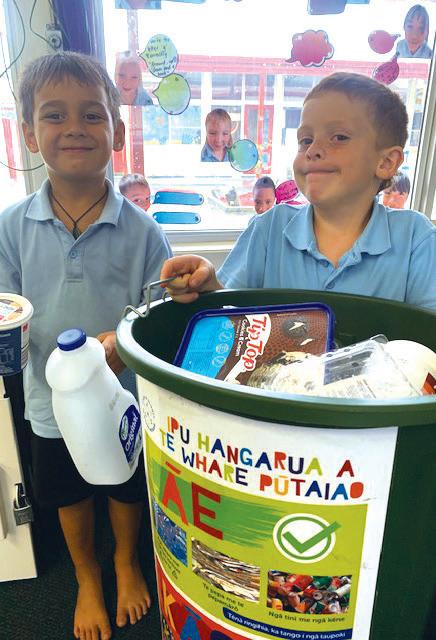
“They’re a massive timesaver for teachers and provide a huge boost to how we deliver science,” says Bruce.
“Our children are getting state-of-the-art science lessons that are having a huge impact. They will tell me about a favourite lesson a whole year later.”
Welcome Bay School started using the kits in 2017. Year 2–3 teacher Julia Bishop says they include all the curriculum links along with learning objectives, lesson plans, questions, links to the science capabilities and mātauranga Māori.

“The science is clearly explained, which saves teachers a lot of time researching,” she says.
Because each kit includes all the necessary equipment for each experiment, the school does not need to have a huge range of science resources, which helps with budget and storage issues too, Julia adds.
Bruce says the children enjoy the learning opportunities and experiments, and progress to intermediate and secondary school with a positive attitude towards science.
“The regular arrival of new science equipment within the kits completely feeds their hunger for new experiences. Many children in parent interviews talk about their love of science now, and parents love anything their tamariki are motivated by,” he says.
Meaningful learning experiences
Both teachers say the hands-on experiences, which allow students to look and feel like scientists, have fuelled their curiosity towards science.
“They are engaged in what we are doing, and I get excited that they are excited!” says Julia.
“It is particularly rewarding when they take the knowledge and language they learn in science contexts
42 Education Gazette gazette.education.govt.nz
Students in Years 2-8 at Opononi School engaging with A Load of Rubbish / He Putunga Para science kit to better tiaki their coastal environment.
and apply it to their play and to other curriculum areas.
“For example, ‘I am investigating’, or ‘I am gathering evidence’, or ‘I am being a problem solver’.”
Bruce says children now seek out science books from the school library to take home to help fuel their curiosity.
At Opononi Area School Year 2–3 teacher Nicky Rogers-Pirini says using the resources schoolwide has helped students engage in topical conversations such as Cyclone Gabrielle and the water system.
“It directly links their thinking to what is scientifically happening in our environment,” she says.
“As a coastal school [beside the Hokianga Harbour], it’s important to give meaningful learning experiences relevant to our environment.”
Two kits that have stood out for the school are A Load Of Rubbish, which looks at how they can tiaki (look after) their harbour, and Big Blue Future, which helps students understand how the ocean is essential in protecting our planet.
Julia says the feedback from parents has been positive too.
“When we share science experiments and activities on Seesaw, parents find it helpful as they can then discuss what the children were learning with them,” she says.
“We found that during lockdown, many families were sharing experiments and kitchen science they were doing at home.”
Integrating mātauranga Māori and science
Te reo Māori and mātauranga Māori are intertwined in the resource kits, with lessons available in both reo Māori and English for kaiako and ākonga.
“We include as much te reo in our science lessons as we can,” says Bruce.
Te ao Māori links such as pūrākau (Māori myths and legends) and references to mātauranga Māori are incorporated within each kit to complement the topic or focus area.
The Volcanoes kit, for example, includes the legend of Rūaumoko, while the Fireworks kit references the legend of how Māui brought fire to the world. The Simple Machines kit explains traditional kōhatu (Māori use of stone tools), and the Food For Thought kit talks about hāngī.
Māori organisations also feature in some kits. Invasion Busters includes Te Tira Whakamātaki, the Māori Biosecurity Network. The Moo To You kit features Miraka, New Zealand’s first Māori-owned milk processing company.
“We don’t claim to be experts, and we acknowledge many pūrākau are specific to iwi or regions,” says Chris.
“But the purpose of the cultural link in our kits is to create opportunities for further exploration and provide kaiako with examples they can then localise.”
Chris Duggan
Cross-curricular opportunities
“We integrate literacy and numeracy with the science learning,” says Bruce.
“We recently used the Simple Machines kit and the learners were extending their vocabulary with words such as pneumatic and hydraulic lifting, pulleys, levers and wedges.”
Growing Science Whakatipu Pūtaiao
• A wrap-around, supportive programme based on extensive evidence and research regarding effective science teaching practice.


• Uses the vehicle of hands-on science inquiry to deliver against the Ministry’s National Priorities of local curriculum design and assessment for learning.
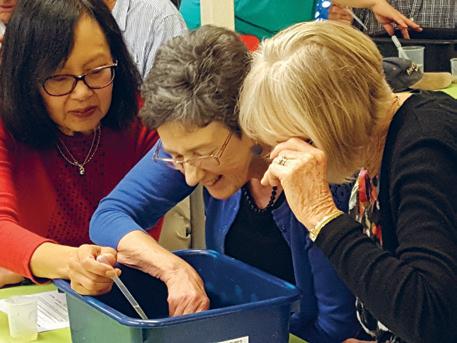
House of Science is an approved MOE PLD provider, servicing primary and intermediate schools in many regions, offering:

• A highly experienced primary science teacher/ facilitator to work with you the teacher, in your classroom.
• A PLD programme that is co-constructed and tailored to the unique needs of you, your school and your community.
• Assistance with the application process for MOE regionally allocated free PLD hours.
Contact
for more info
43 Tukutuku Kōrero 24 April 2023
pld@houseofscience.nz
T E
WHARE PŪTAIAO HOUSE OF SCIENCE ®
“Children are telling their whānau that they act and think like scientists when doing everything from reading and solving maths problems, to gardening and exploring their local environment.”
One of the tasks involves measuring the diameter of a variety of wheels and then measuring how far each wheel would travel with one rotation.
“It was awesome mathematics, with a real purpose,” he says.
“The kids are hypothesising, predicting, problem solving – all in a hands-on classroom setting, and learning mahi tahi (collaboration with their peers). Science, mathematics and literacy all go hand-in-hand.”
Increasing engagement
In April 2021, the Education Review Office released its findings from New Zealand school visits conducted in 2019, and found the science resource kits were an effective means of increasing student engagement in the subject for Years 5–8.
ERO also found the kits helped to reduce teachers’ reluctance to attempt experimental science in class.
“The House of Science kits form a diverse range of the science strands, which gives kaiako the ability to teach even areas they are not confident about,” says Julia.
House of Science currently services 650 primary and intermediate schools across 20 regions, making up more than 30 percent of all primary and intermediate schools in New Zealand.

Approximately 15 percent of House of Science member schools are full immersion kura. The kits are booked online by teachers in member schools.
Chris says they receive no government funding for developing the kits, but do get Enriching Local Curriculum funding.
For example, the funding pays for the loan of a live hive of bumblebees if a teacher wants to enrich the learning in the What’s the Buzz? He Aha Tērā Huhū? kit.
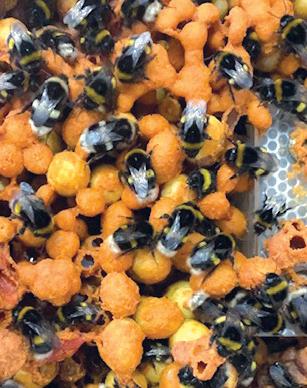
“However, we do rely on grants, sponsors, donors and volunteers to deliver this core curriculum resource to our schools,” adds Chris.
Chief executive of the Royal Society of Chemistry, Dr Helen Pain, says as society faces many challenges, educators can give children the tools to advance their understanding of the world around them, and science learning can help them solve many problems they encounter.
“It’s of vital importance that we recognise the crucial role that educators play in the advancement of the sciences,” she says. “And that we commend their ability to inspire and nurture the next generation of bright young minds, so they can go on to make new discoveries and innovations.”
Chris says the kits will be updated in line with the 2025 science curriculum refresh.
44 Education Gazette gazette.education.govt.nz
At Opononi School, students enjoy using the What’s the Buzz? / He Aha Tērā Huhū? kits.
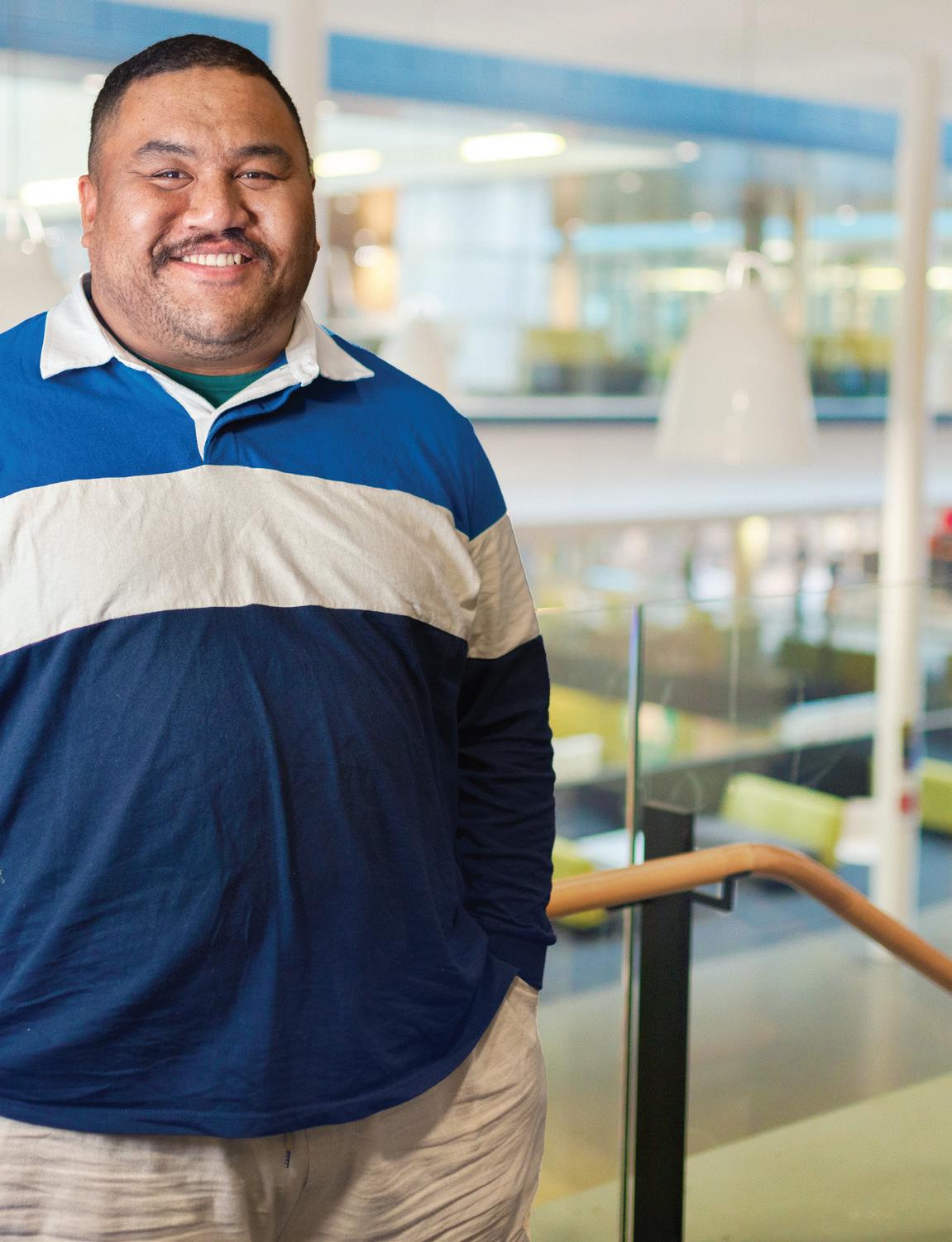
Find out more goteach.education.govt.nz
Jaistone, BA (Hons) student
‘Thanks to Miss Lorenzen, I always remember where I come from.’
Rural school strengthens place at heart of community
At the heart of its community, Burnham School Te Kura o Tiori in one of Aotearoa’s fastest-growing populations, is experiencing the benefits of a major property development project and refreshed cultural narrative.

Burnham School Te Kura o Tiori in Selwyn, Canterbury, is a cornerstone in the community, not only to the many local families in the area but also for those families who work for the New Zealand Defence Force.
The school is experiencing a transformative makeover with the first stage of development now complete, and the remaining works to be complete by August. Refurbished buildings have transformed old classrooms into open and flexible learning environments for students, and the cultural narrative has also been strengthened.
With a current roll of 133, the school caters for students in Years 1–8. As one big family, where everyone knows your name, the school is aiming to strengthen its place at the heart of its community.
Principal Pauline Jansen says the new learning spaces reflect the cultural narrative of the school. The first block including new signage has given the school a physical lift
as well as a new presence in the community.
“You can now see our school from the roadside –shining!”
Post Covid, the school is experiencing a roll increase, with new families choosing the school because of its links to the rural environment and the easy access from nearby Rolleston which has seen rapid population growth and urban development.
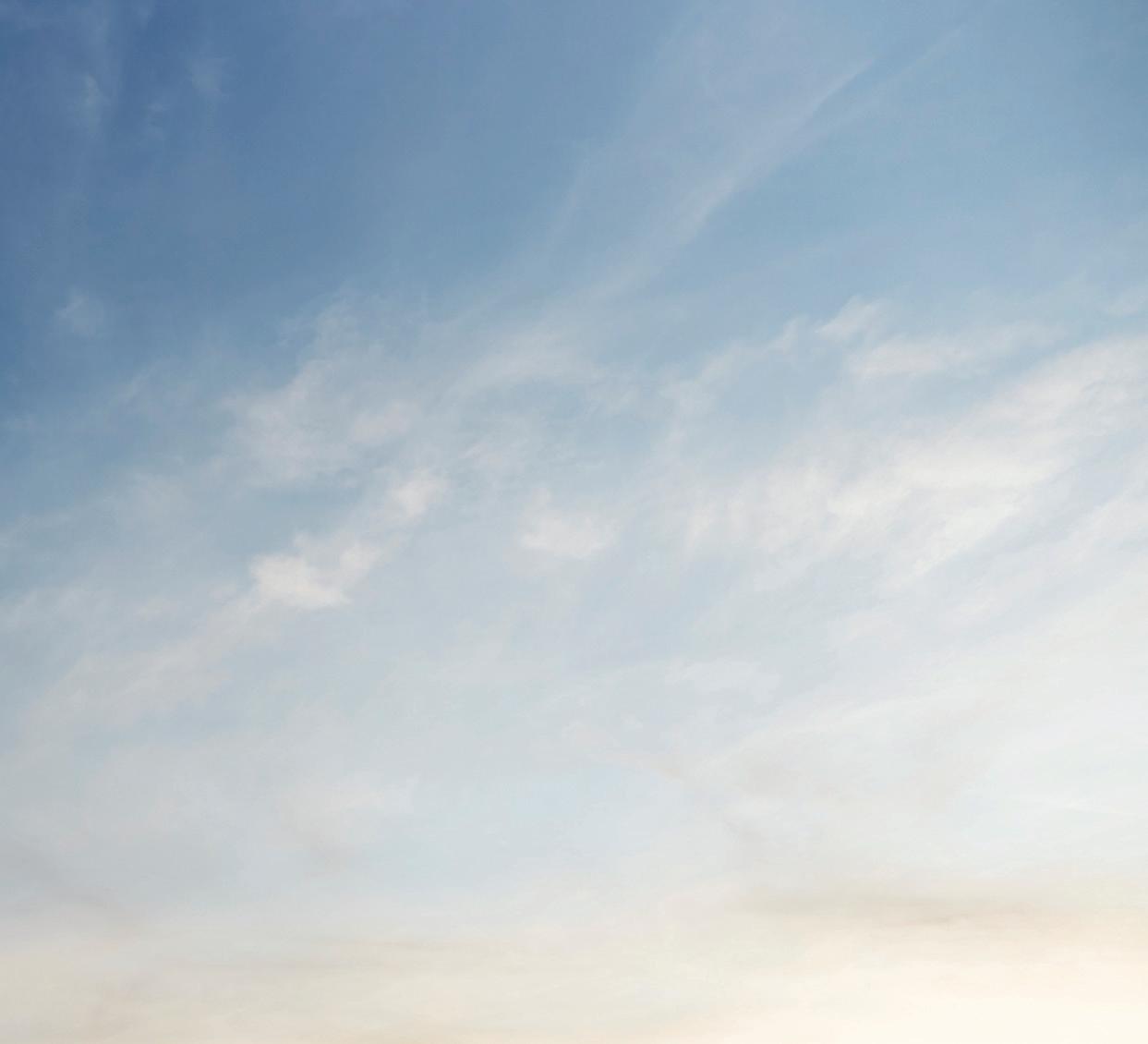
Burnham School once solely served some of the families of the New Zealand Defence Force with Burnham Military Camp next door.
Over the last few years, the school demographics have begun to evolve with the growth of Selwyn District and Rolleston.
“Our school has always been at heart of our community; and we are seeing our students immensely proud of where they learn.”
46 Education Gazette
SCHOOL INFRASTRUCTURE
Ākonga are proud of their new learning spaces.
Community connections
Involvement with the wider community is important to Burnham School. Over the past 18 months, the school has been improving connections with local early learning services.
It’s also been engaging the wider school community when planning its future.
“This was a particular focus when the community was involved in our re-visioning of the school and the introduction of our ‘Learner Actions – Respect, Effort and Pride’,” says Pauline.
“These learner actions form part of our everyday expectations for ourselves, our learners and the whānau community who come into our school each and every day.”
The children and whānau enjoy the small learning community, the structured approach to teaching, and the sense of belonging.
“Our whānau feel connected and engaged in their children’s learning and our staff work hard to ensure that our learners receive the best possible learning experiences.”
New ways of working
With the new buildings now occupied by eager-to-learn students, Pauline says there has been an obvious change in the way students are learning.
They are more engaged and excited to learn, with the classrooms absorbing sound, making learning more focused with less distraction.
“Our Year 1–4 learners and staff are proud of their new learning spaces and speak of how cool they are into the summer and warm in winter, how roomy they feel and that they love the breakout spaces for extra learning,” she says.
The buildings also feature new decking and overhanging roofs, keeping students dry and sheltered from wintry storms.
New air conditioning in the rooms is proving to be a great asset for the hot nor-wester days the school experiences.
“With our modern learning facilities, we have noticed the quality of learning has improved and that our sense of belonging, as a kura, has significantly improved,” says Pauline.
A key goal for the school this year is putting in place a three-year strategic plan that reflects its learners’ future aspirations and those of the wider community.
“We want to ensure that our local curriculum comes fully alive not only for teaching and learning but also physically in our school,” says Pauline.
“We are delighted that our new facilities and the facilities to come will truly reflect the cultural narrative that we have worked so hard, as a school and community, to develop.”
Strengthening culture
Another important aspect of Burnham’s new developments is the new school values; manaakitanga, whanaungatanga, tiakitanga, kohtahitanga, and rangatiratanga.
Burnham School Te Kura o Tiori has had a relationship with Te Taumutu rūnanga for many years. Te Taumutu gifted the name Te Kura o Tiori and the school’s new values as part of the refreshed cultural narrative, which is woven into the local curriculum and used in everyday learning.
With Pauline’s leadership, the relationship between the kura and mana whenua has further strengthened through multiple hui to build whanaungatanga.
The kura also provides a bilingual level 2 provision, and many families from around the district travel to the school to take part in this programme. There are currently 40 students enrolled in the bilingual provision, almost half of the school role.
Pauline says bilingual learning is personalised to the age and learning stage of each student.
The older learners meet in small groups throughout the week, and the younger students learn during day-to-day lessons in their classroom.
“Bilingual provision will continue to be an important part and an aspect of our school that is celebrated,” she says.
A significant cultural taonga has also been unearthed from safe-keeping in storage and will be proudly on display.
The carving, made several years ago by students, local artists and Kaumātua Denise Sheat, depicts the local story of their area.
This is the story of Tū Te Rakiwhaānoa and the Rākaia River, written by Cath Brown for the children of Taumutu.
Pauline says the carving is planned to be centred in the heart of the school as it’s directly linked to the school’s local curriculum.
“As this piece of work is key to our school’s cultural narrative, it’s important that it’s given its rightful place for all to see and enjoy.”
*
47 Tukutuku Kōrero 24 April 2023
For student teachers, PCT1 and PCT2 or AFFORDABLE $20 for individuals, $50-$100 for schools WITH MANY BENEFITS
Regular pānui with unique resources
Conference discounts
support
NZ Assocation of Science Educators membership for primary à secondary teachers is FREE
*
*
* Teaching
A national voice representing you.
www.nzase.org.nz/membership
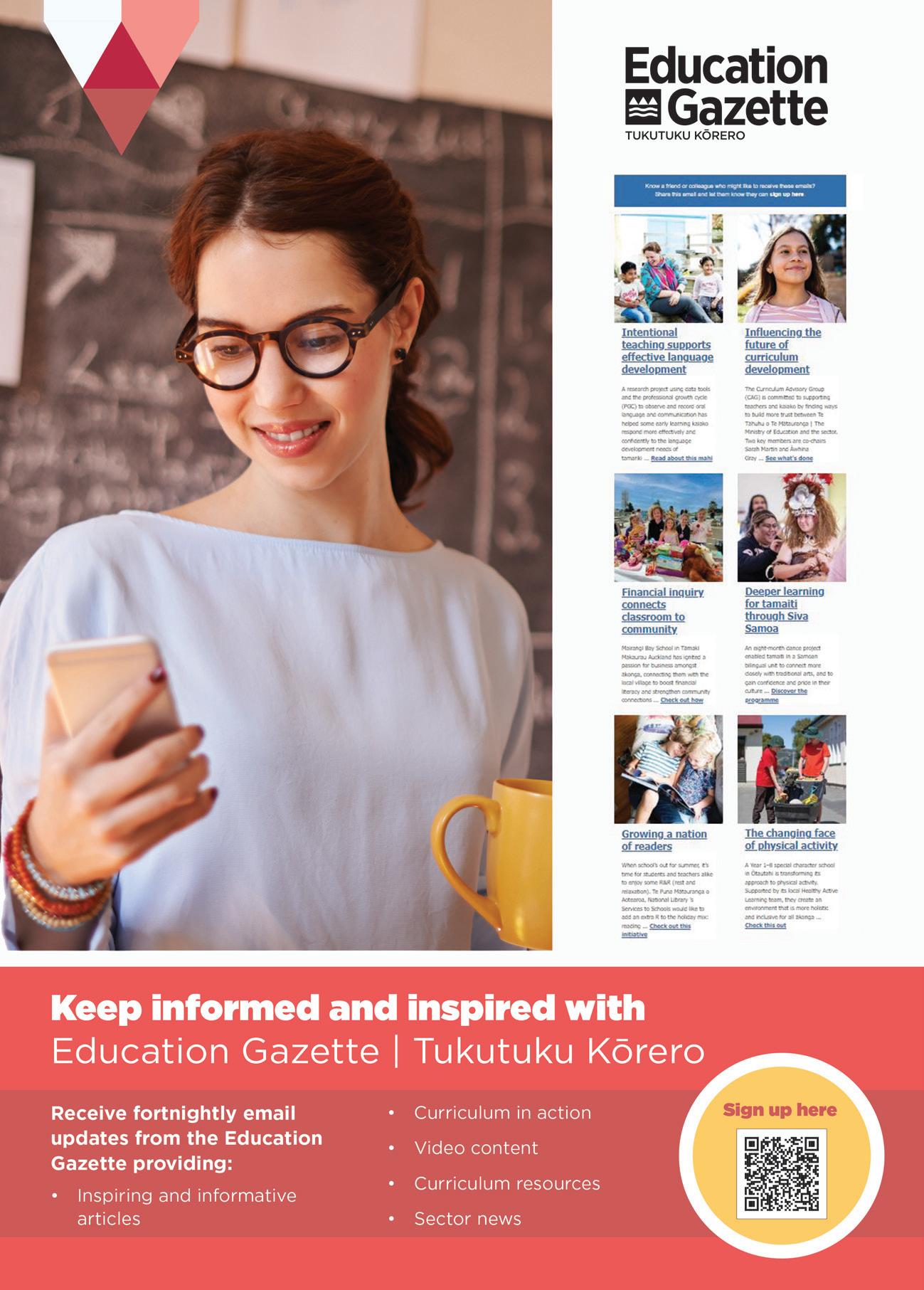
Our dedicated principal of sixteen years is moving to Taupo Intermediate School, and we are seeking a worthy successor to replace him.
We are an innovative Intermediate school with a roll of 330 young people.
Our school is known for providing an environment and culture of inclusiveness, collaboration, and excitement.
OTAHUHU INTERMEDIATE SCHOOL
Principal/Tumuaki U5 plus concurrence for RTLB and South Auckland Attendance Service.
We are seeking someone who is a very competent leader, has strong personal and interpersonal skills, excellent curriculum knowledge, proven ability to lead learning, and has a well-developed child-centred education philosophy. Having competence in administrative leadership would be an advantage as the school has responsibility for an RTLB Cluster and the South Auckland attendance service.
We are seeking an experienced, highly motivated, and energetic leader who will embrace the journey we are currently on and be committed to our school and community’s dreams and vision for young people.
We are embedding Te Ao Maori into our school culture and have a warm and supportive relationship with whanau. The school is expected to have three new bi-lingual classes for Māori, Tongan and Samoan Students early 2024.


Otahuhu Intermediate is a well-resourced school, and we are fortunate to have a very dedicated and professional staff
Our vision is “Excellence for All”.
Application packs are on the KEA website: www.keaeducation.nz. For the application form email Terry on Terryh@keaeducation.nz. To visit the school by appointment email: office@otahuhuint.school.nz. For questions on the process phone or email Terry Hewetson HEDSOL an affiliate of KEA. 021 2719 001 terry.hewetson@gmail.com
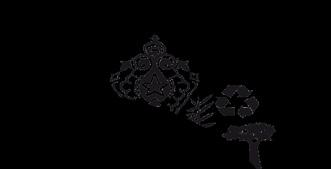

Closing date is 7th May 2023 at 5.00 pm. Interviews are on Saturday 27th May 2023. Starting date is Term Three 2023.
Our Principal is leaving after 7 years at the helm. We now seek a Principal who will continue our school’s positive journey. We are looking for an enthusiastic, committed, culturally responsive leader who will work positively alongside our whānau, staff and students.

Taita College was built in 1957 and is a school that serves its community. The college is a vibrant, coeducational, multicultural, state-funded secondary school.

At present, we have around 380 students. The ethnic composition of our 380 students is Māori 46%; Pasifika 29%; European 21% and Other 4%.

Taita College is diverse, and inclusive of many different cultures. The connection to the environment and land is of most significance. We will be looking for an exceptional leader who is approachable, empathetic, able to build positive connections and someone who will work in partnership with our staff, our whānau within our local community and most importantly, with our students.
Taita College priorities for Principal Appointment:
• Depth and understanding of culturally responsive practices and the ability to engage with a diverse demographic
• A skill set that actively promotes a progressive curriculum
• Confident to lead and develop restorative practices, where relationships are critical
• The ability to lead and manage the implementation of a new build and building refurbishments in the school
• Awareness of the NCEA change package and new initiatives, with a focus on literacy and numeracy.
Applications close on Friday 19th May 2023
If you would like an application pack please email: Rebecca Garlick • secretary@taita.school.nz
RECRUITMENT 49 Tukutuku Kōrero 24 April 2023
Taita College Principal/Tumuaki U5
the QR codes with the camera on your device. VACANCIES NOTICES PLD
To view the PLD, general notice listings and vacancies at gazette.education. govt.nz
Scan
Running a creative project for ākonga in 2024?
Check out Creatives in Schools
The Creatives in Schools programme provides funding of up to $17,000 per project.

Your project can be any type of artform such as visual, performance, design, digital arts, Pacific arts and ngā toi Māori.
Round 5 opens June 2023
Plan ahead and start preparing your application along with your partner artist or a creative professional ahead of the opening date.
For application tips and checklist, visit: creativesinschools.tki.org.nz
For questions, email: CreativesinSchools@education.govt.nz































 Reg Blake is tumuaki at Te Kura Kaupapa Māori o Otepou.
Reg Blake is tumuaki at Te Kura Kaupapa Māori o Otepou.



































 Year 5 student Lilah of Pou Uta, Year 6 student Benjamin of Pou Nui, and Year 5 students Maia of Pou Roa and Louie of Pou Tai.
Year 5 student Lilah of Pou Uta, Year 6 student Benjamin of Pou Nui, and Year 5 students Maia of Pou Roa and Louie of Pou Tai.

























